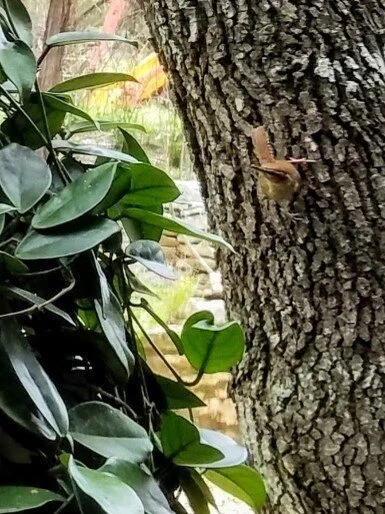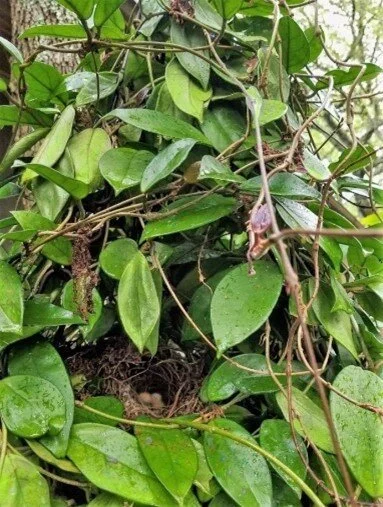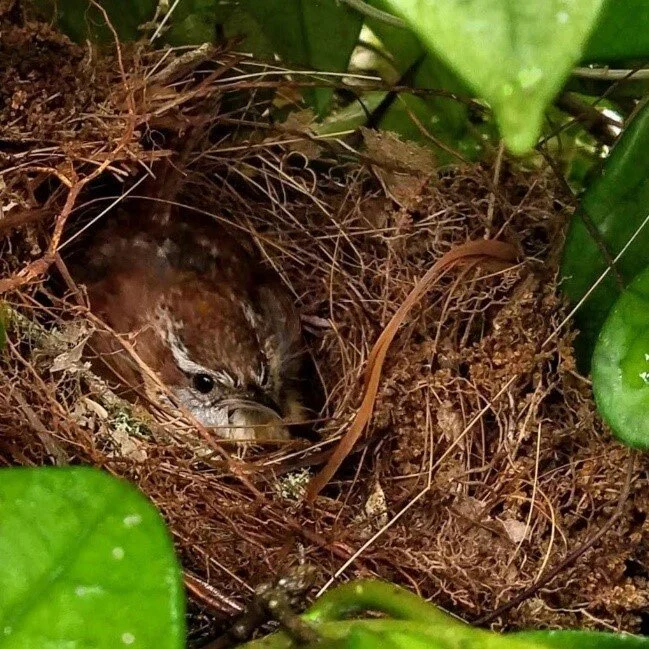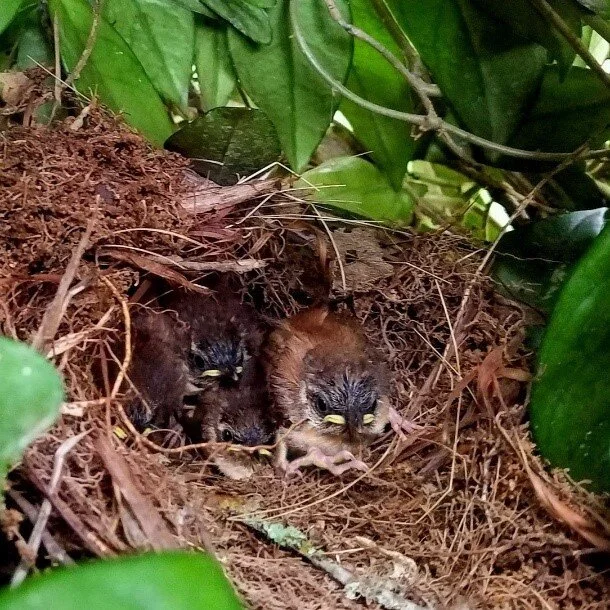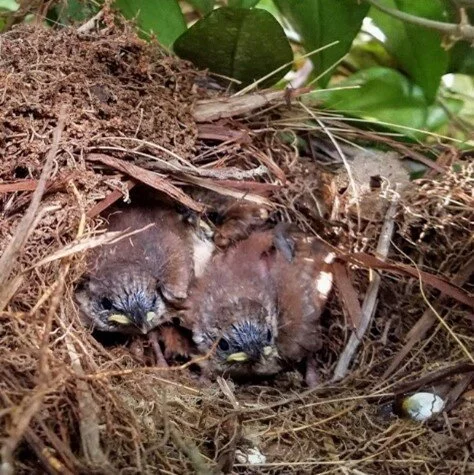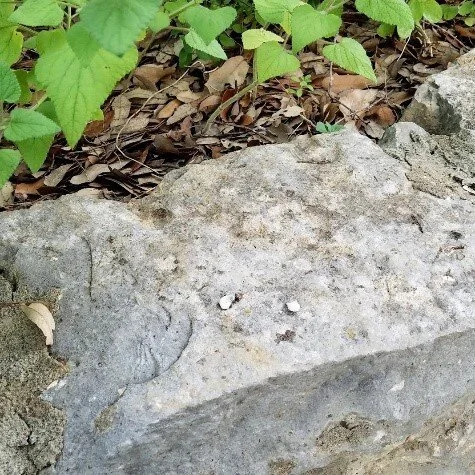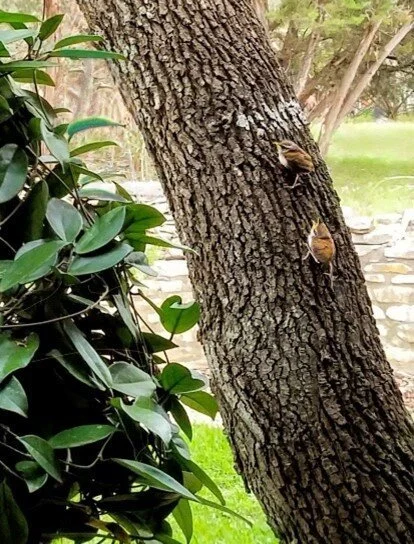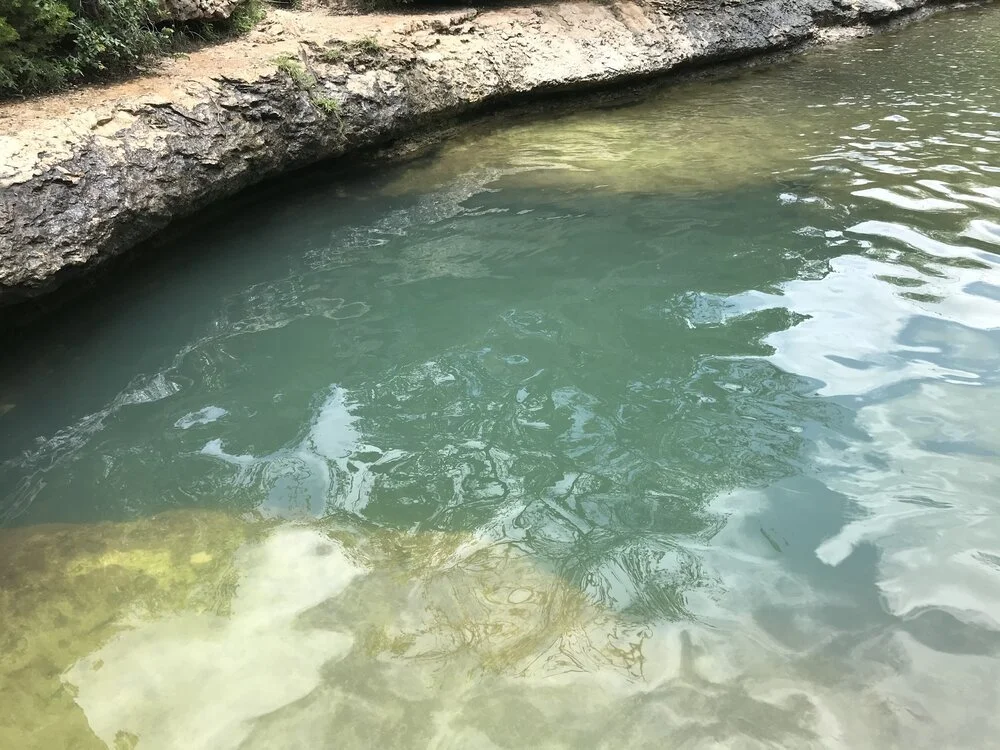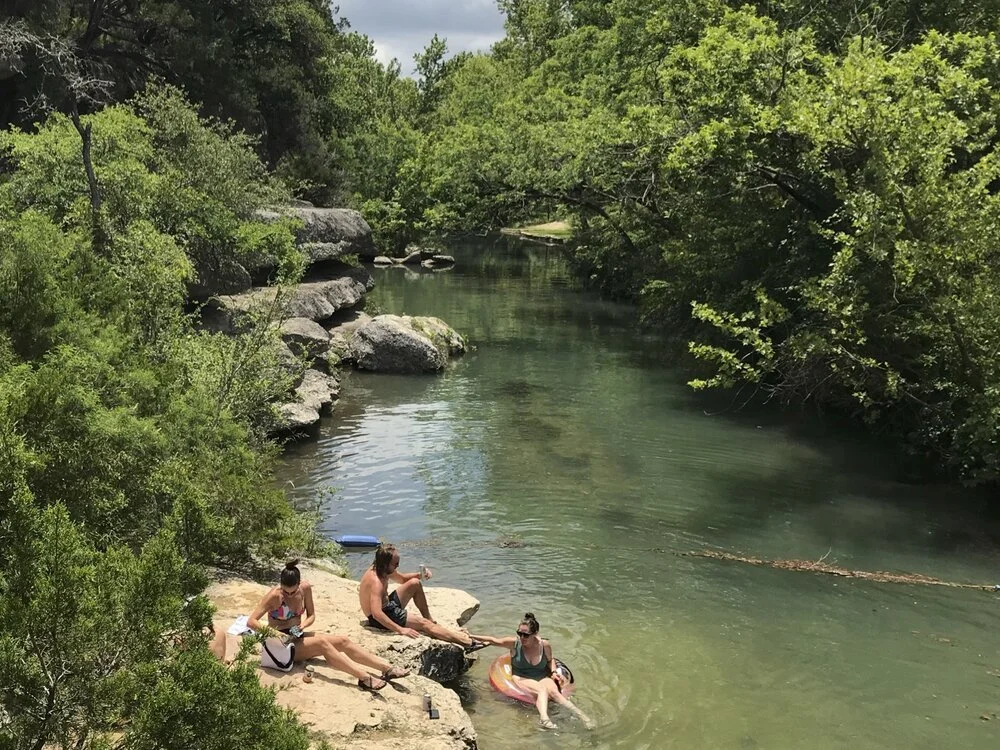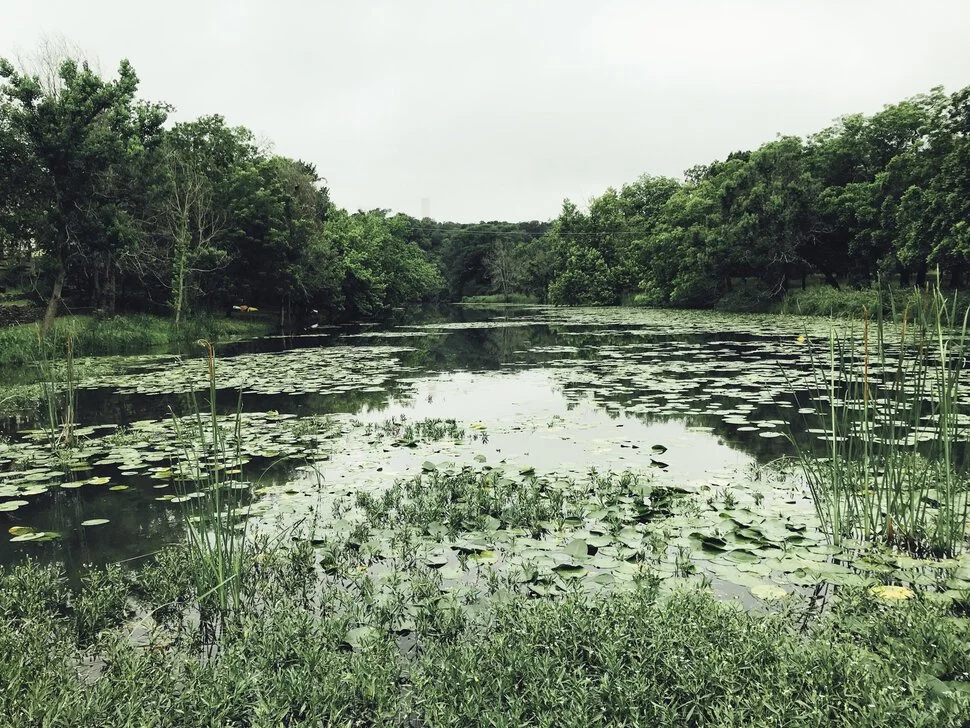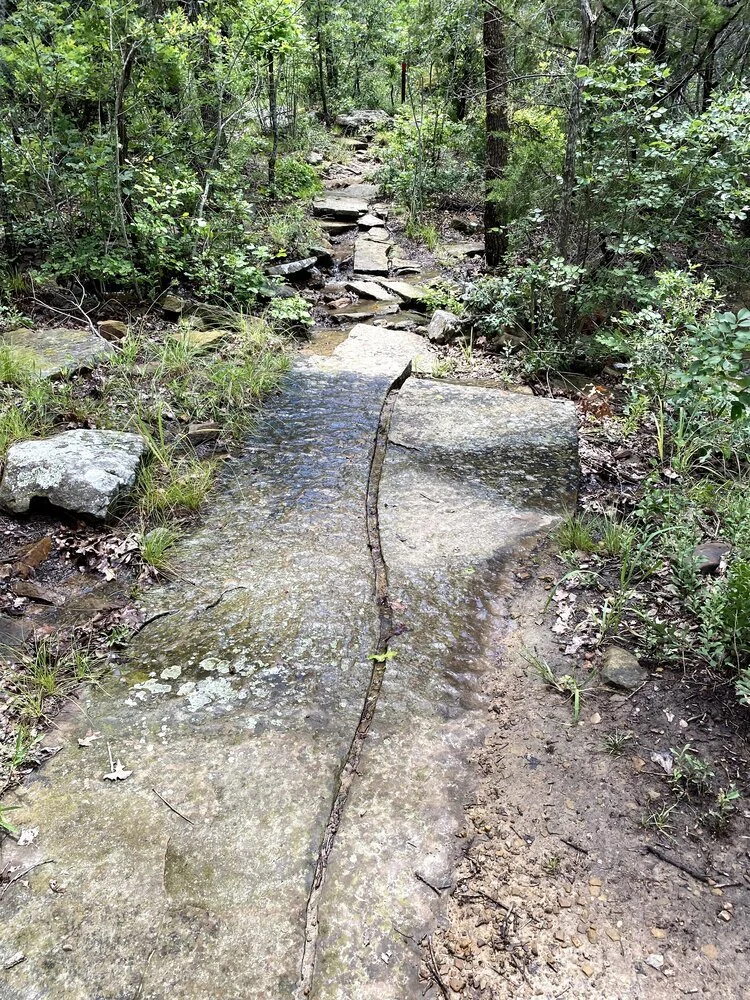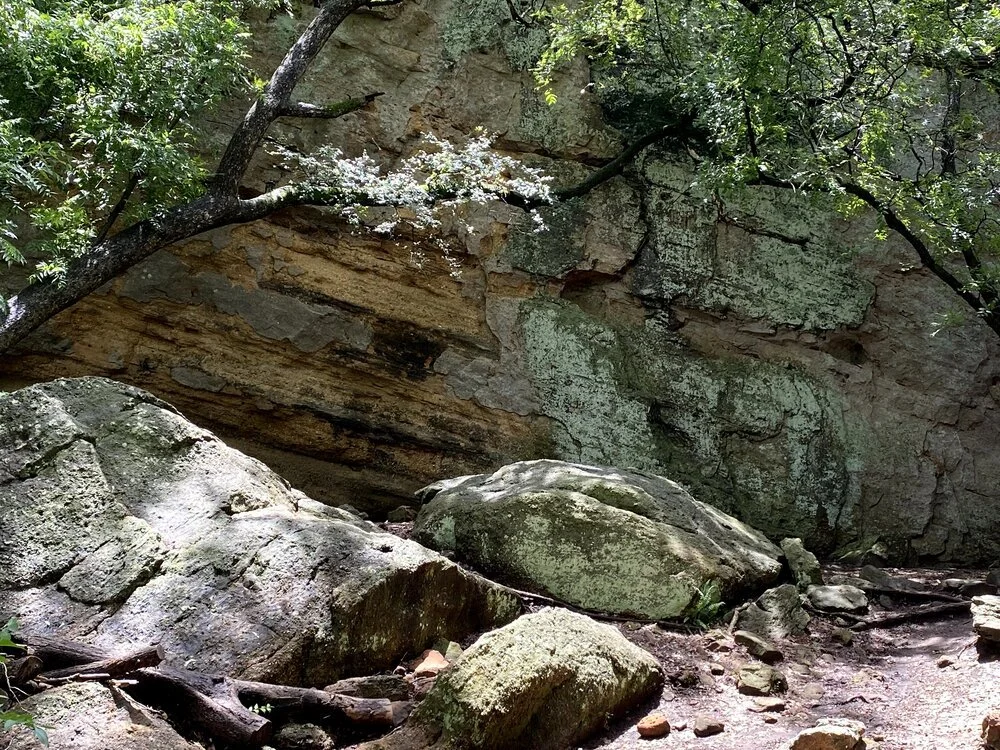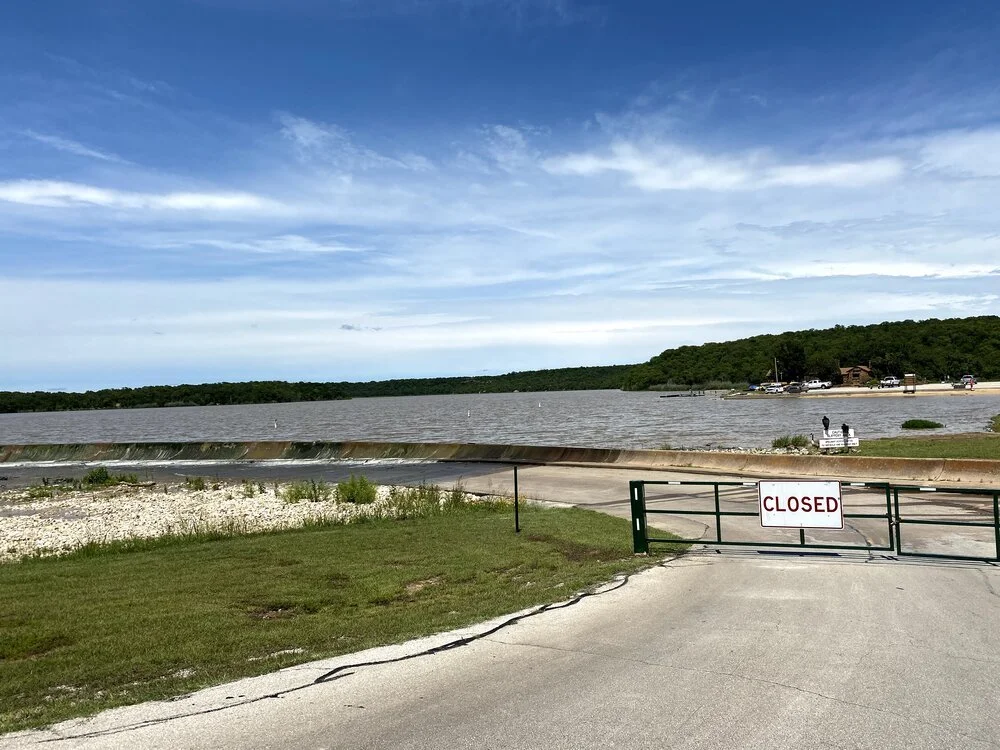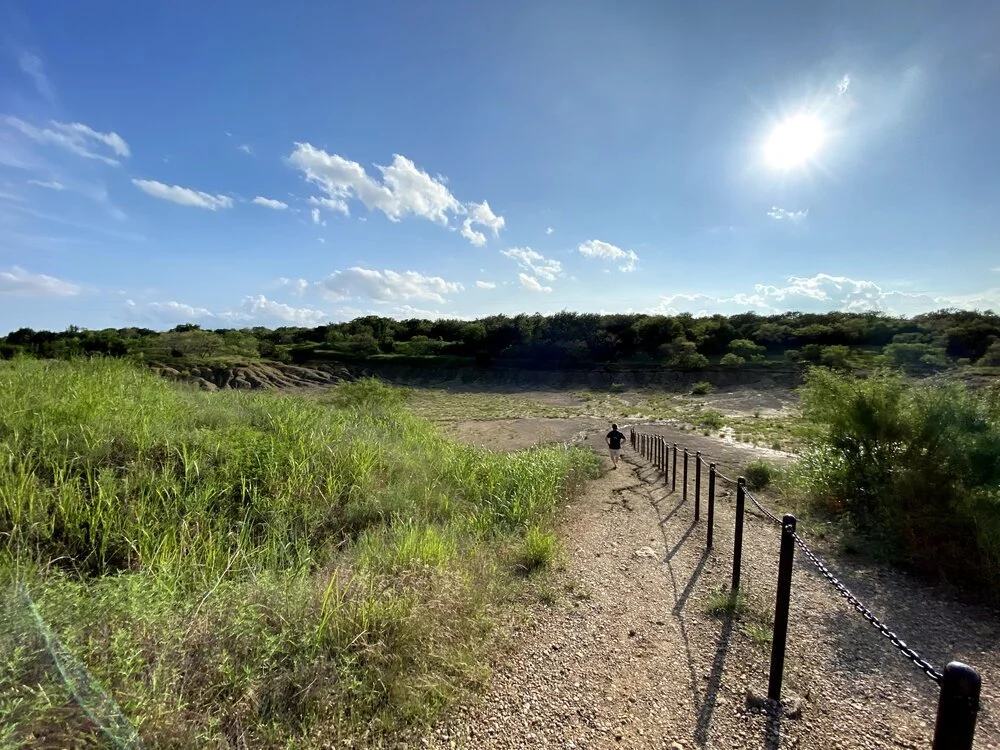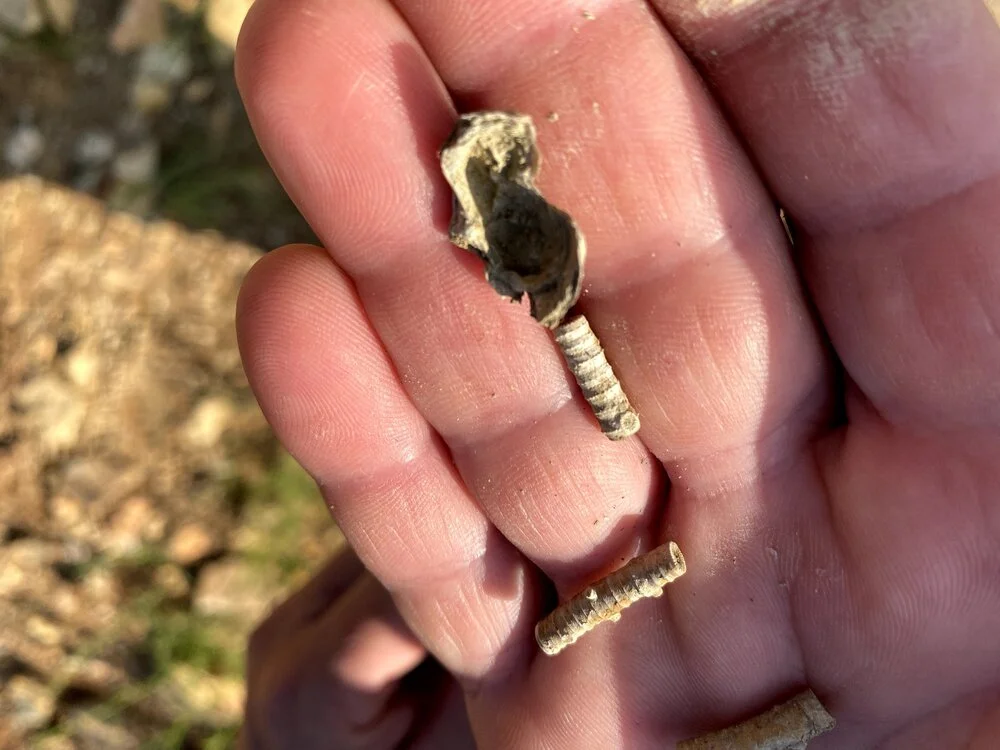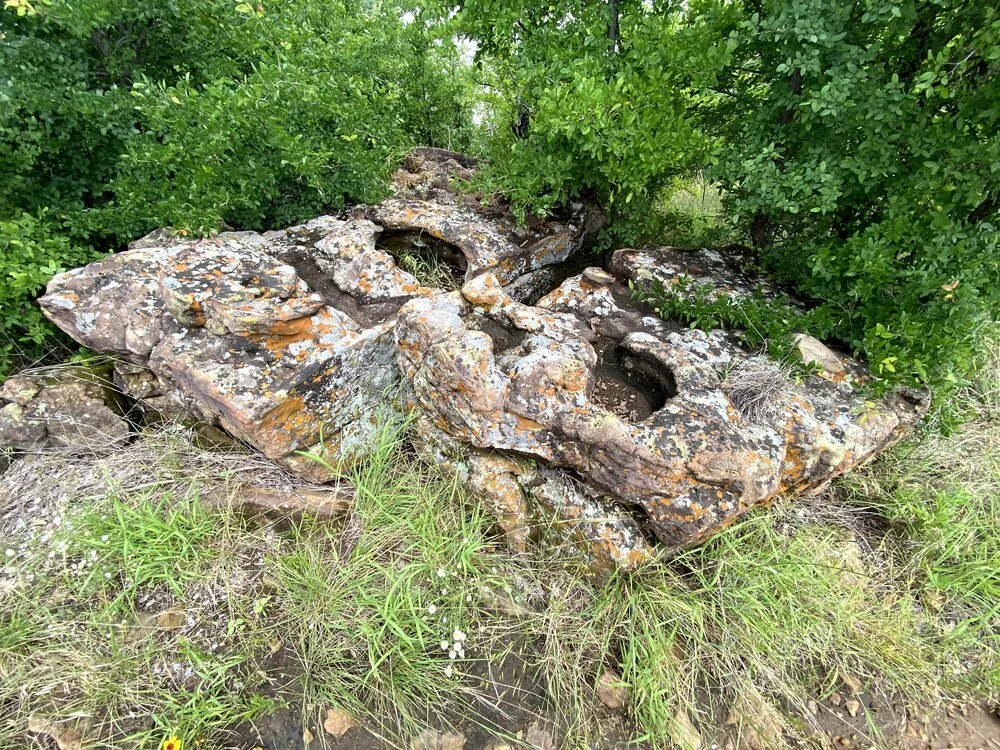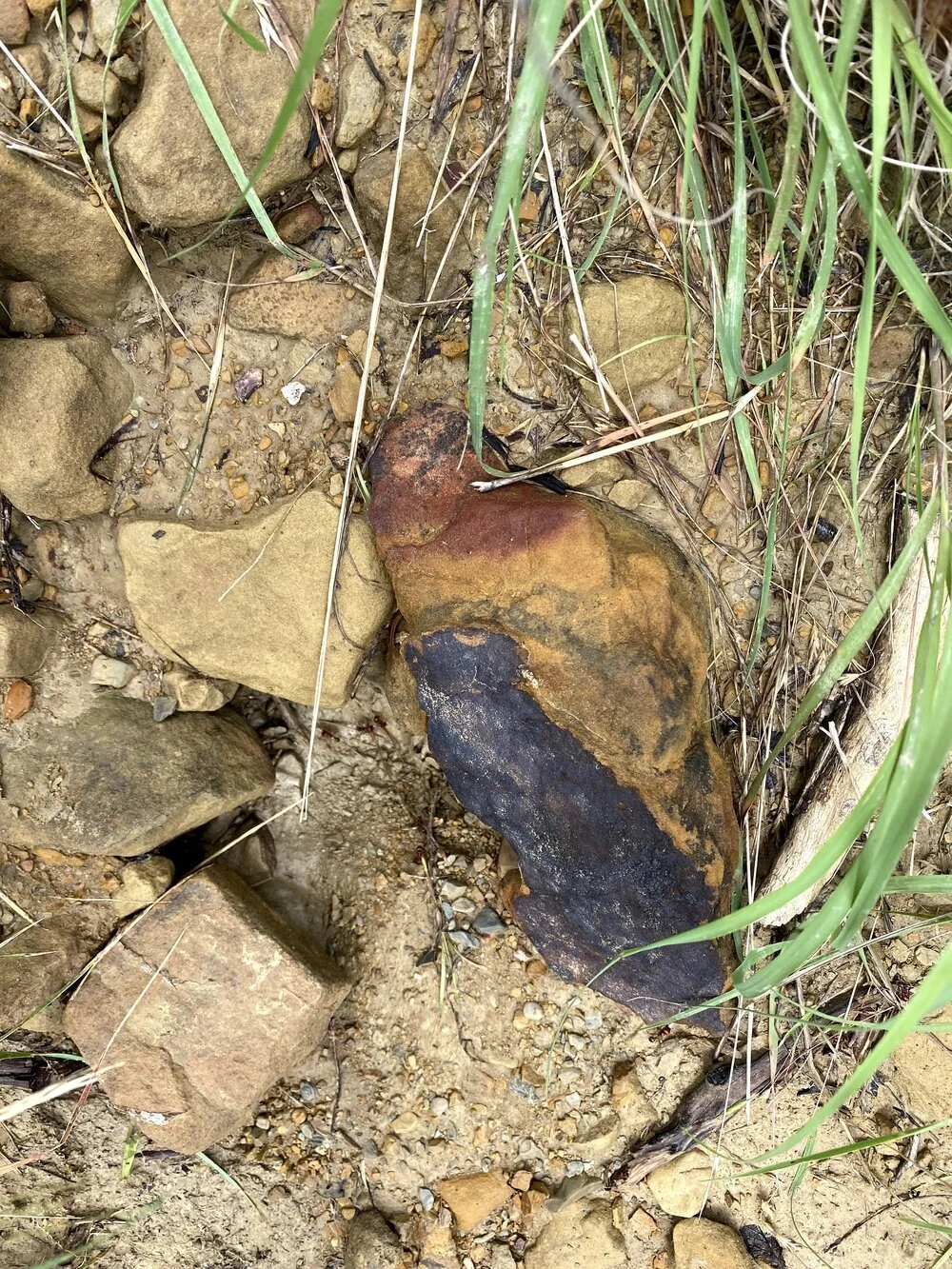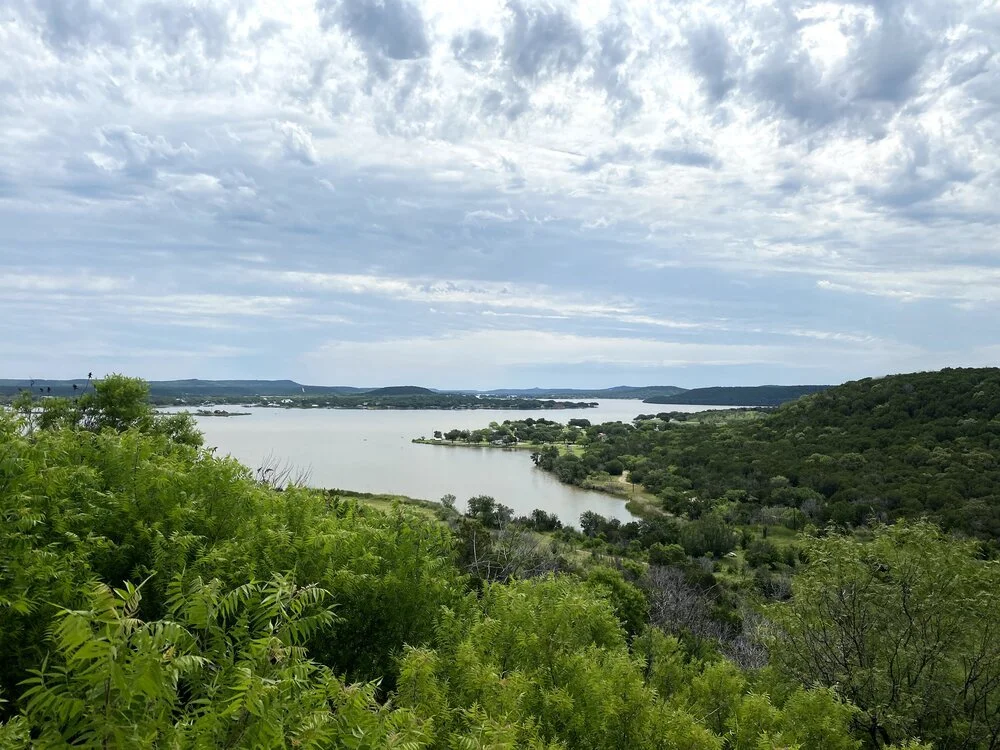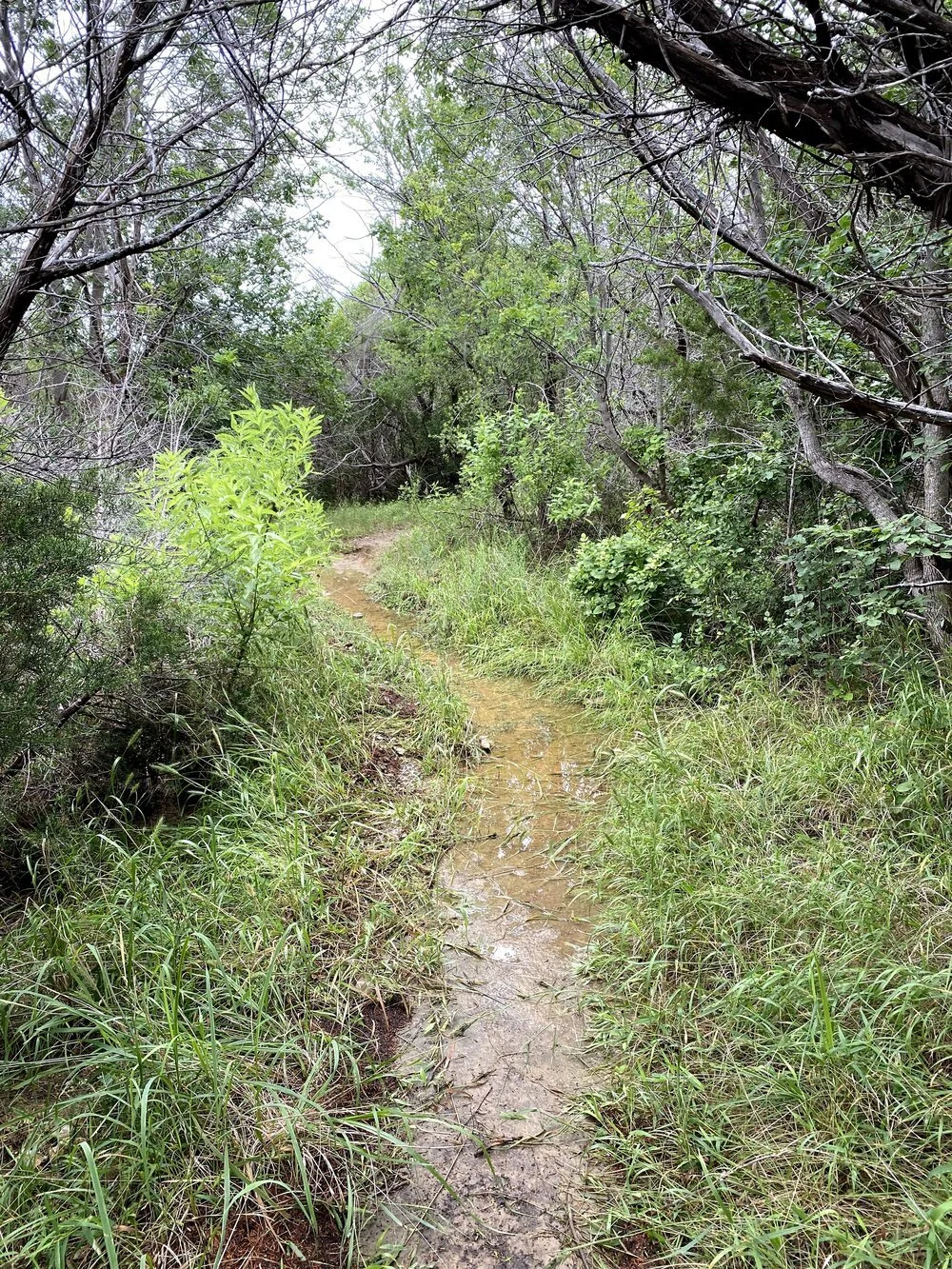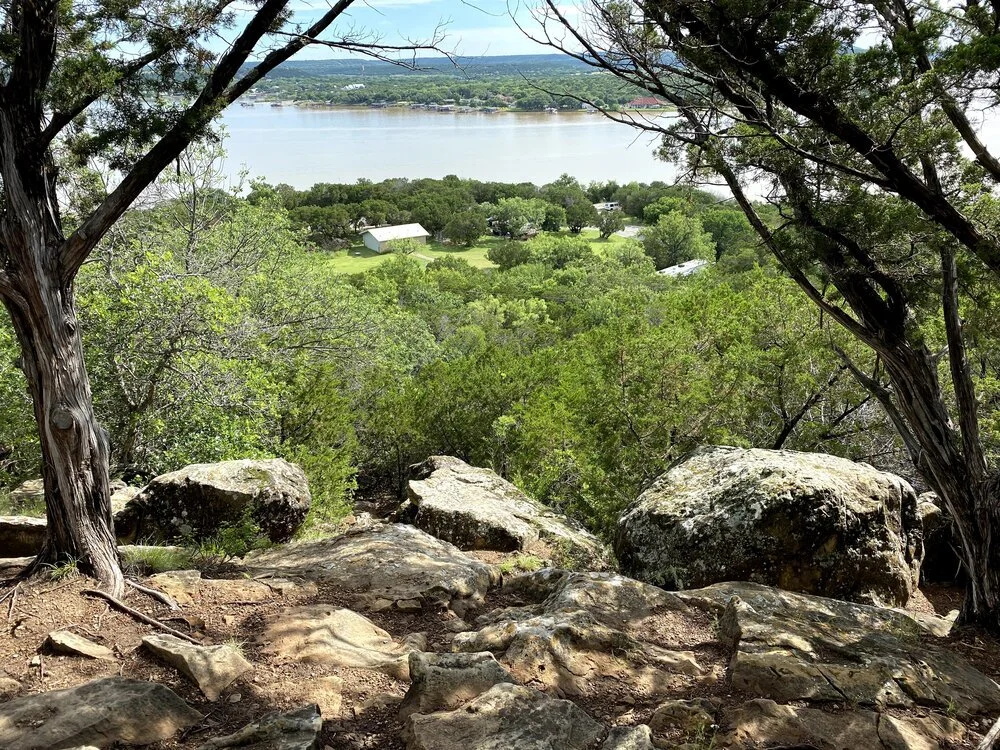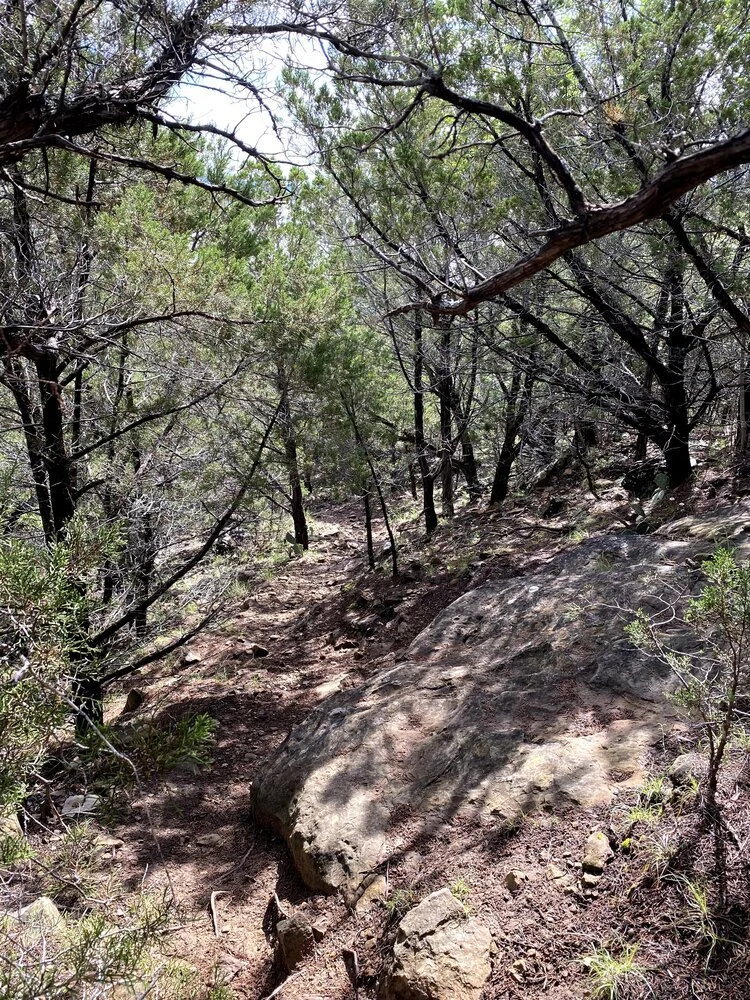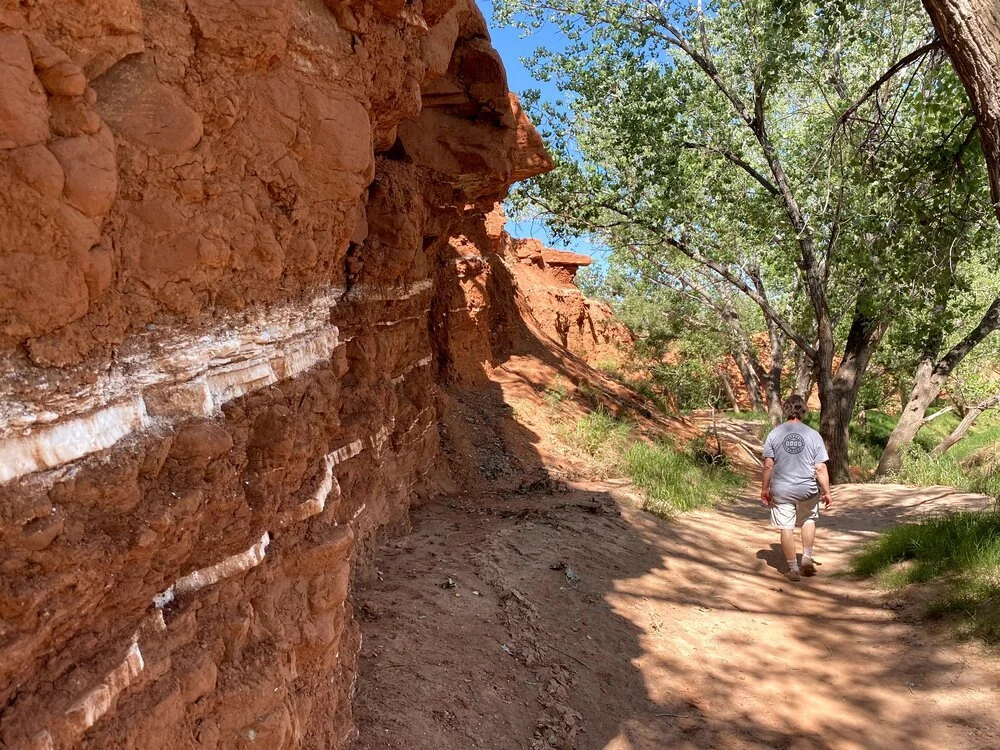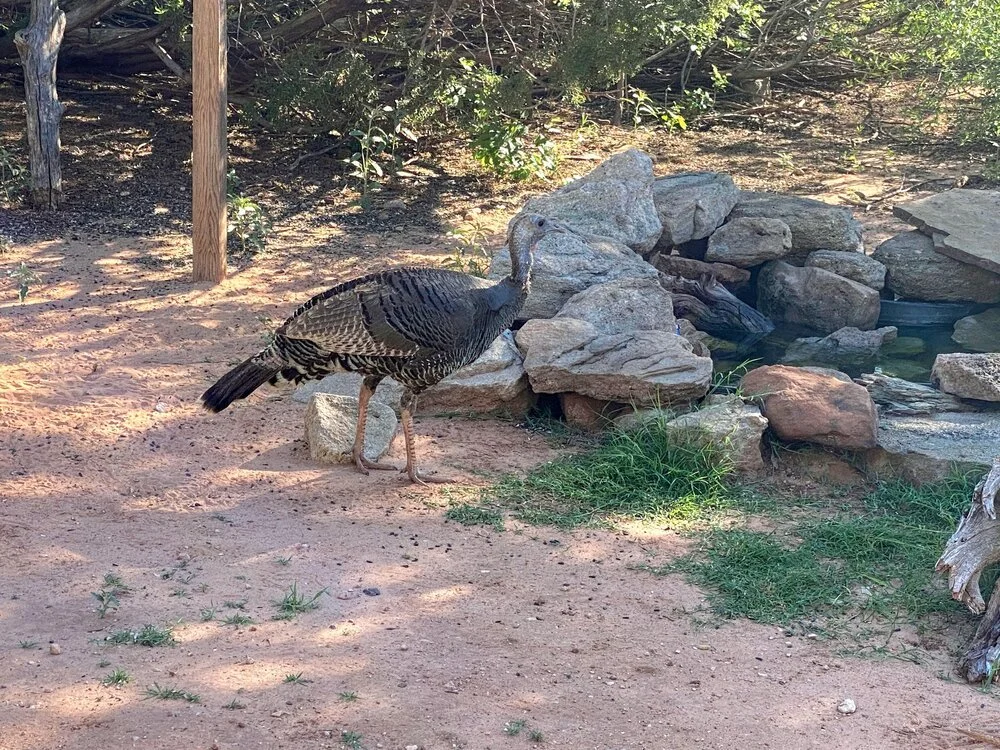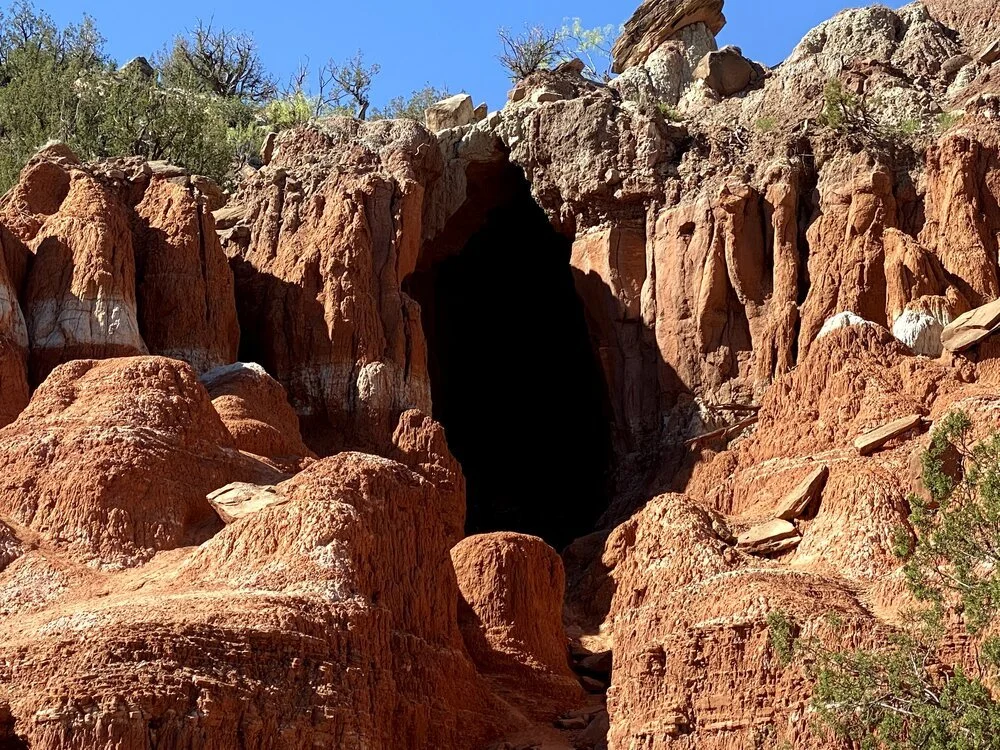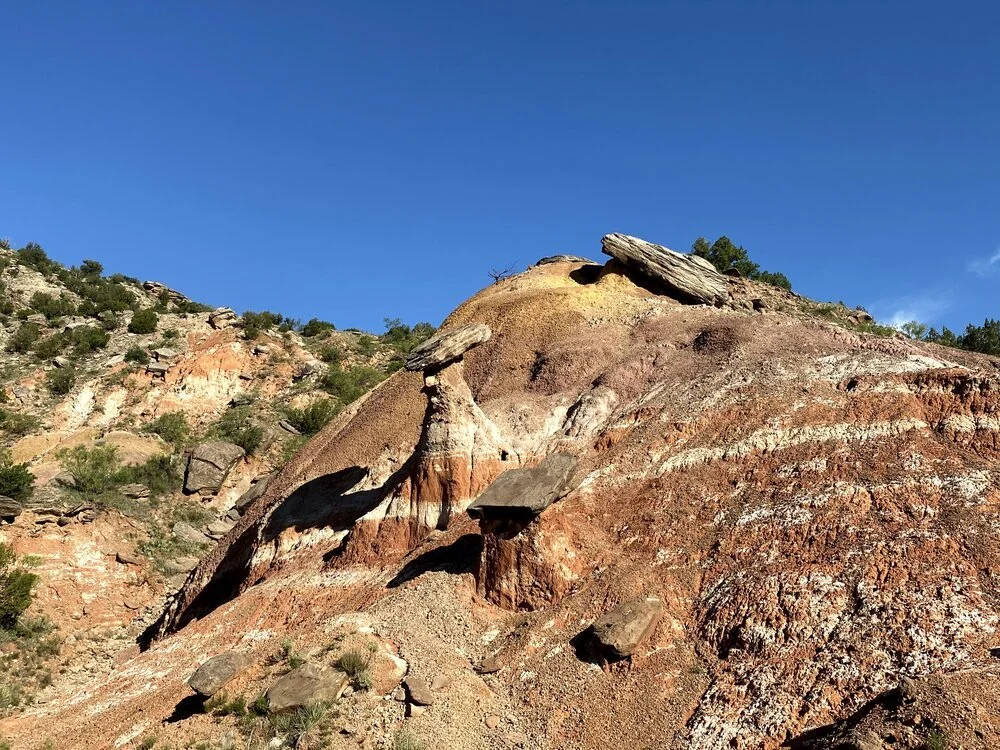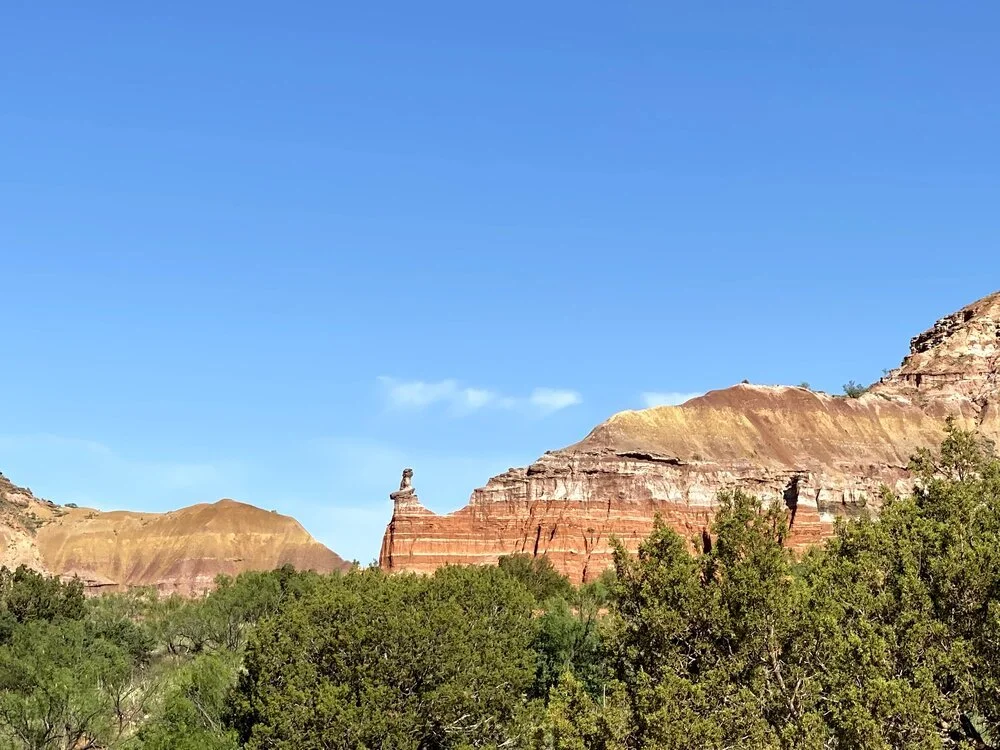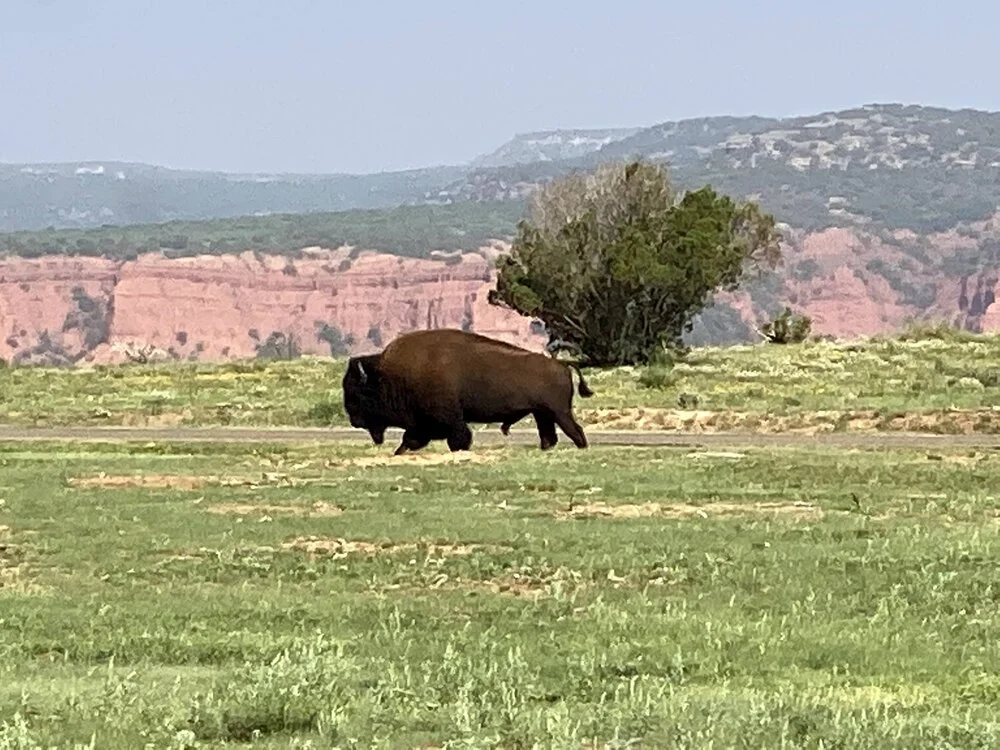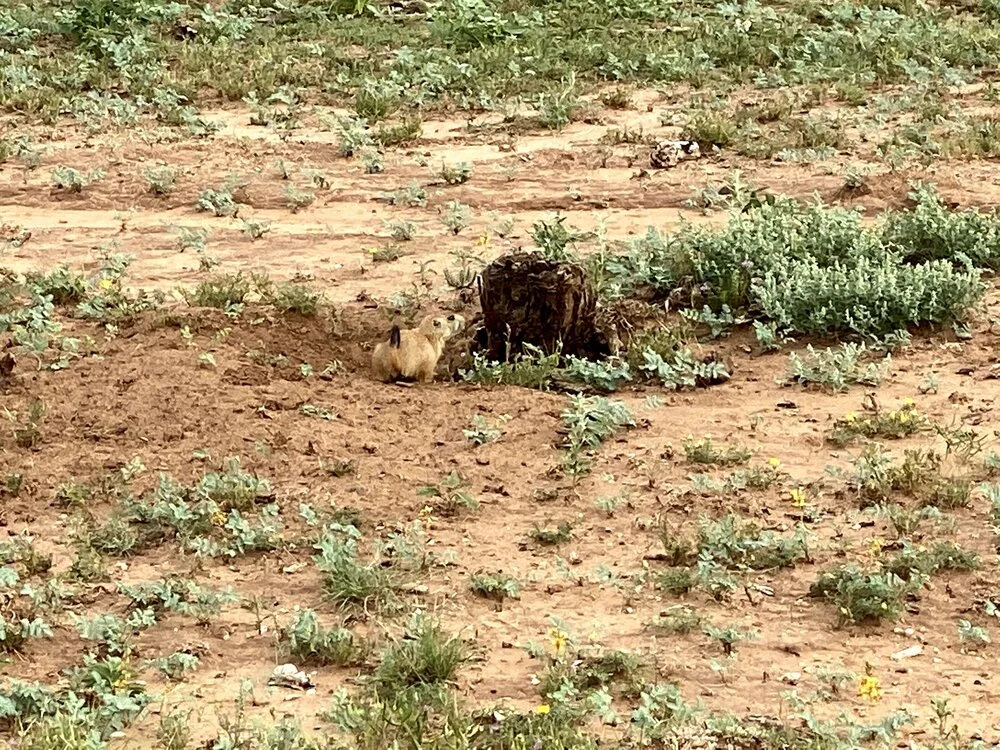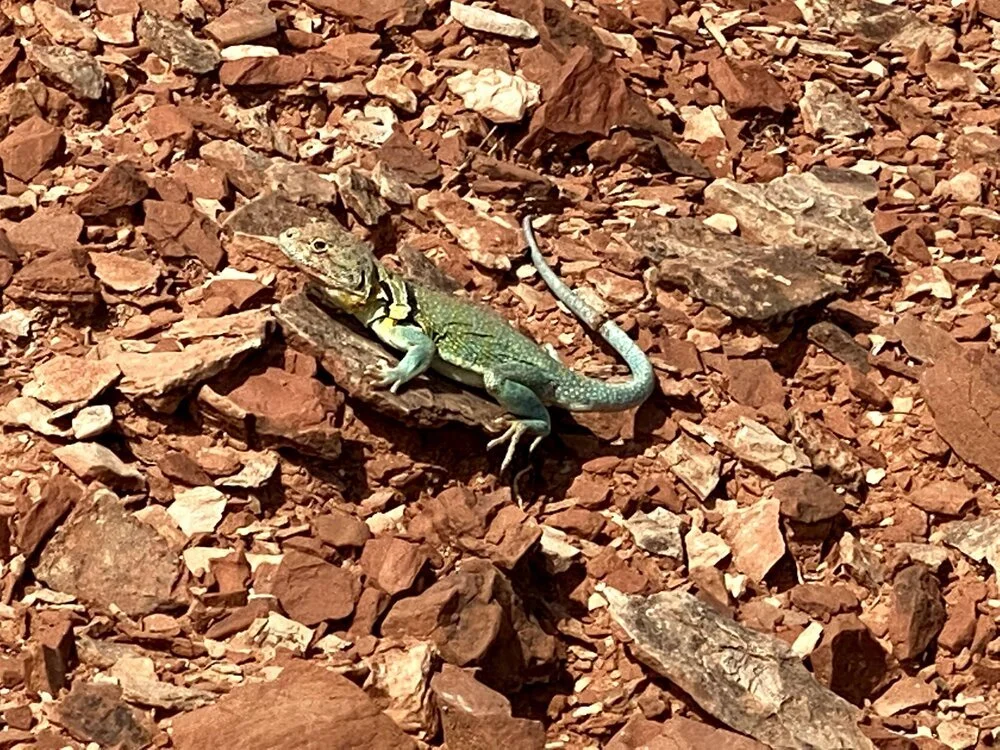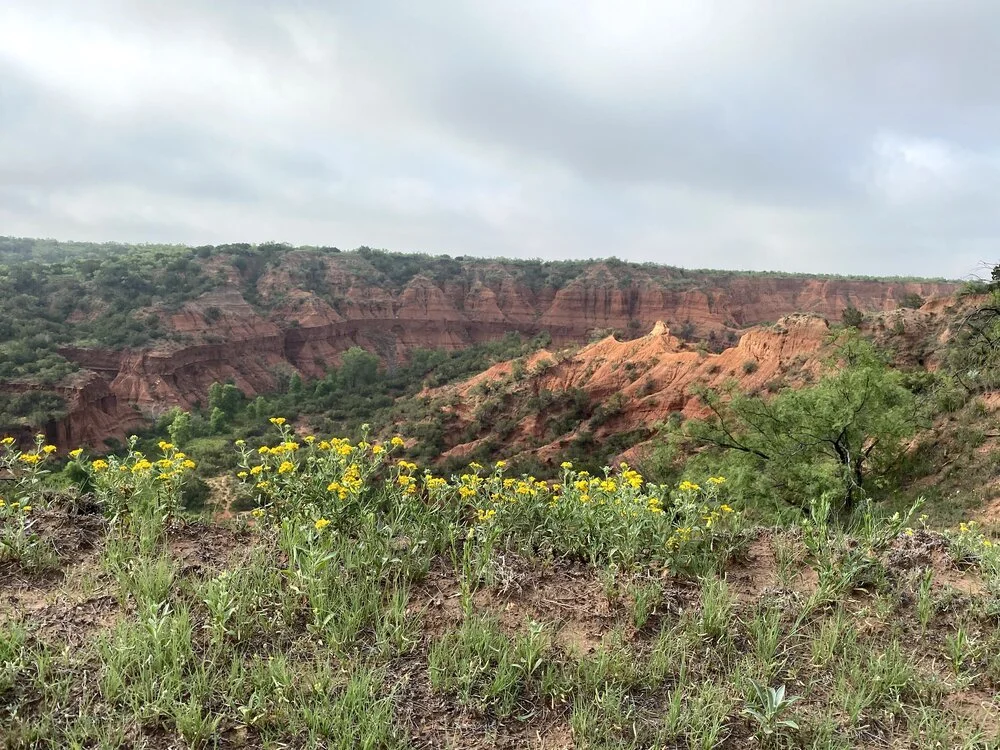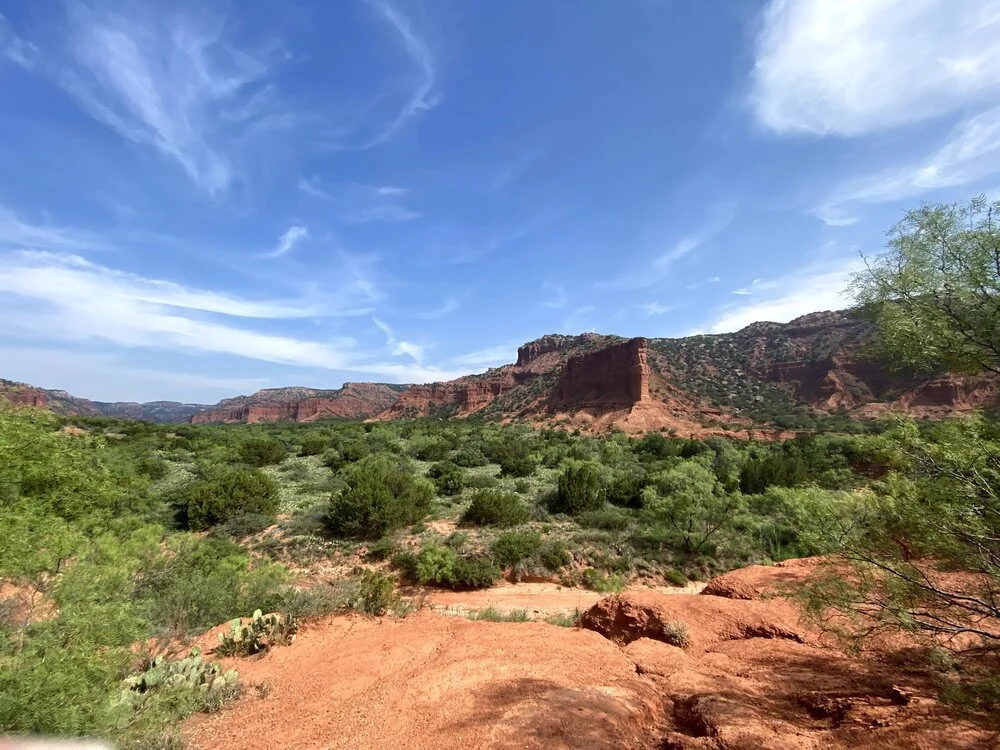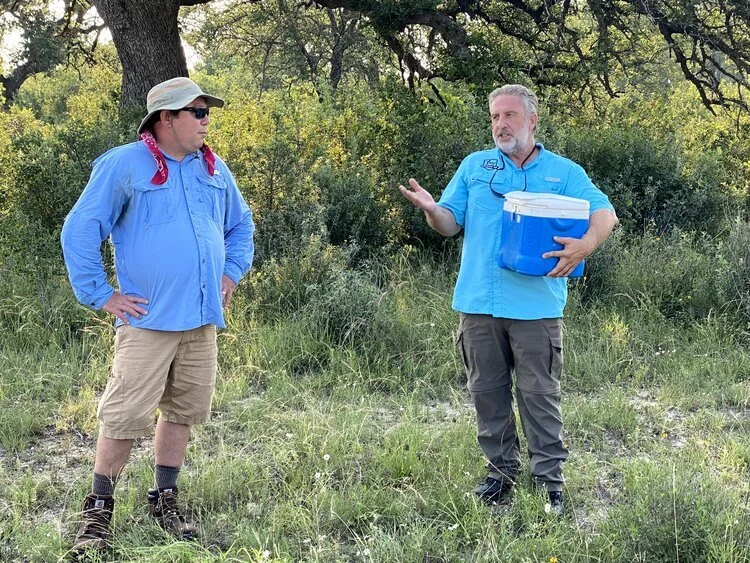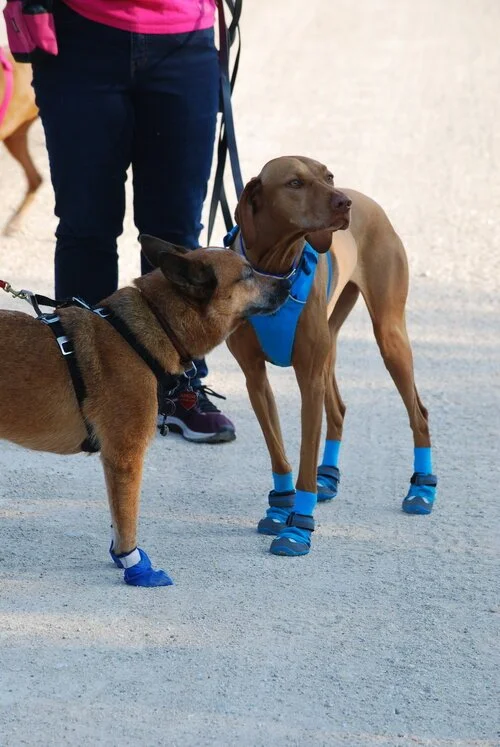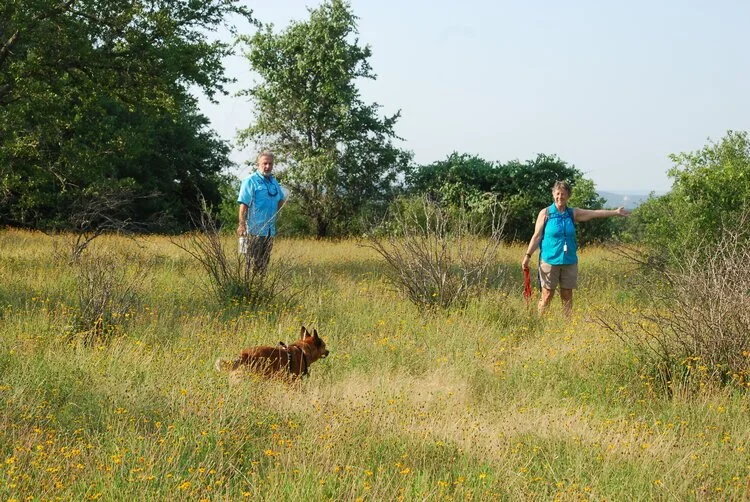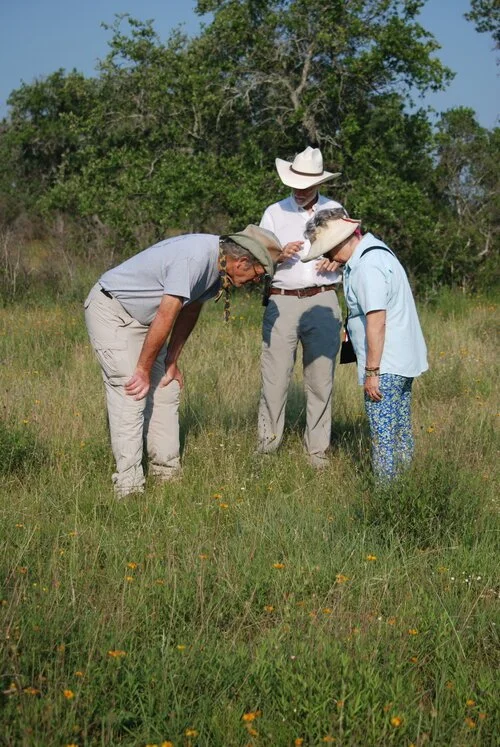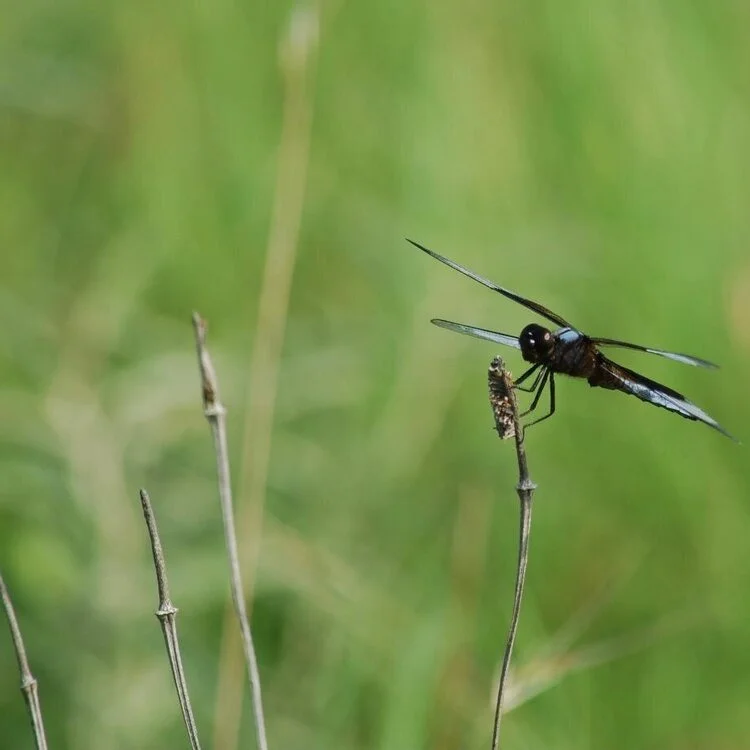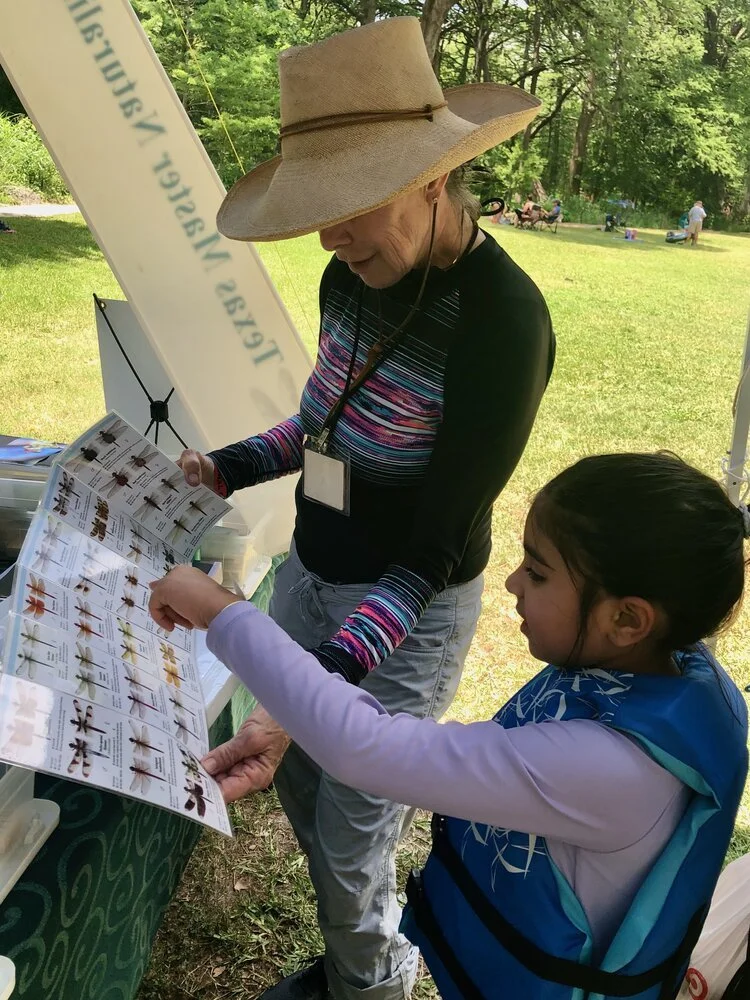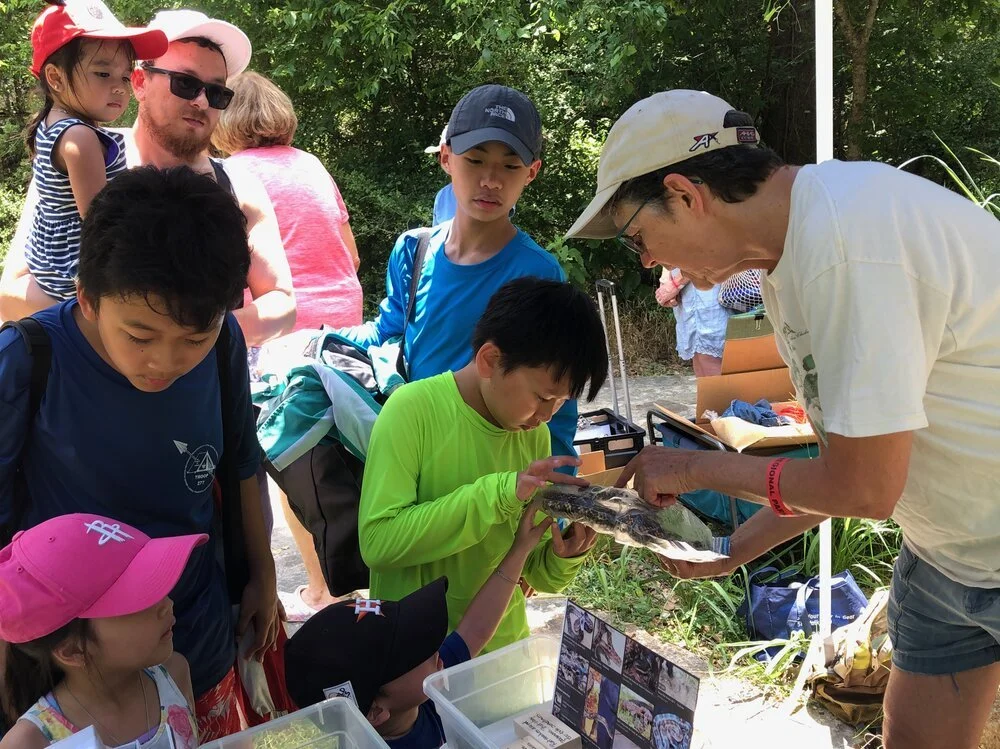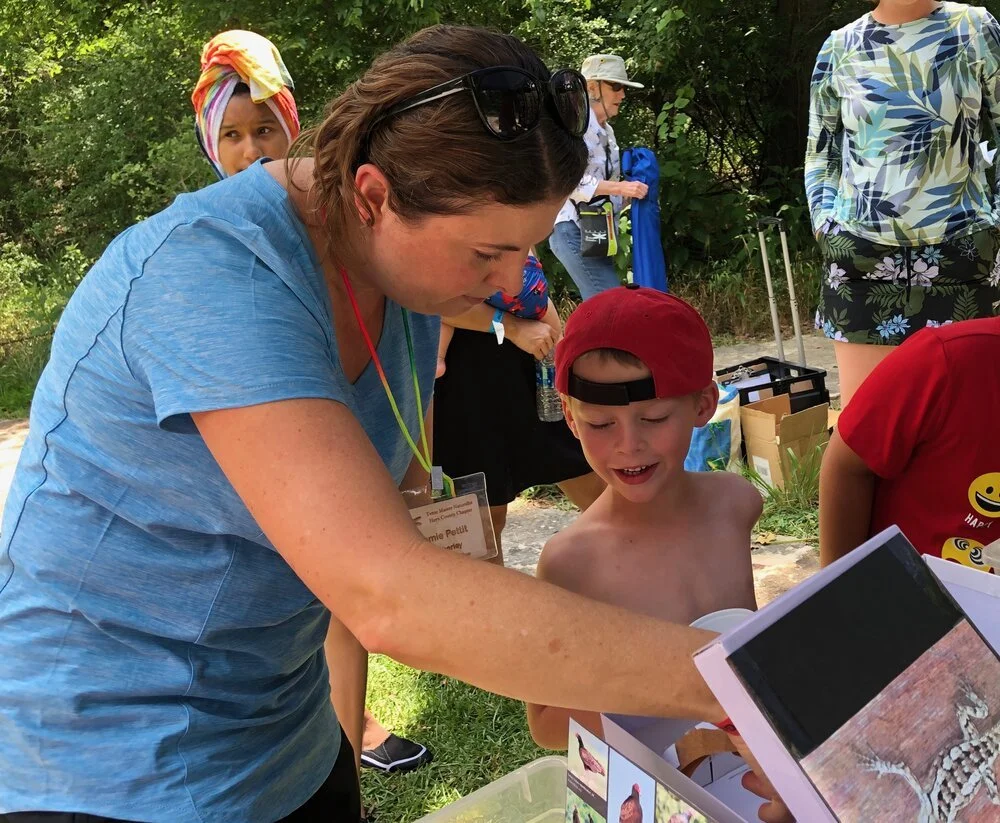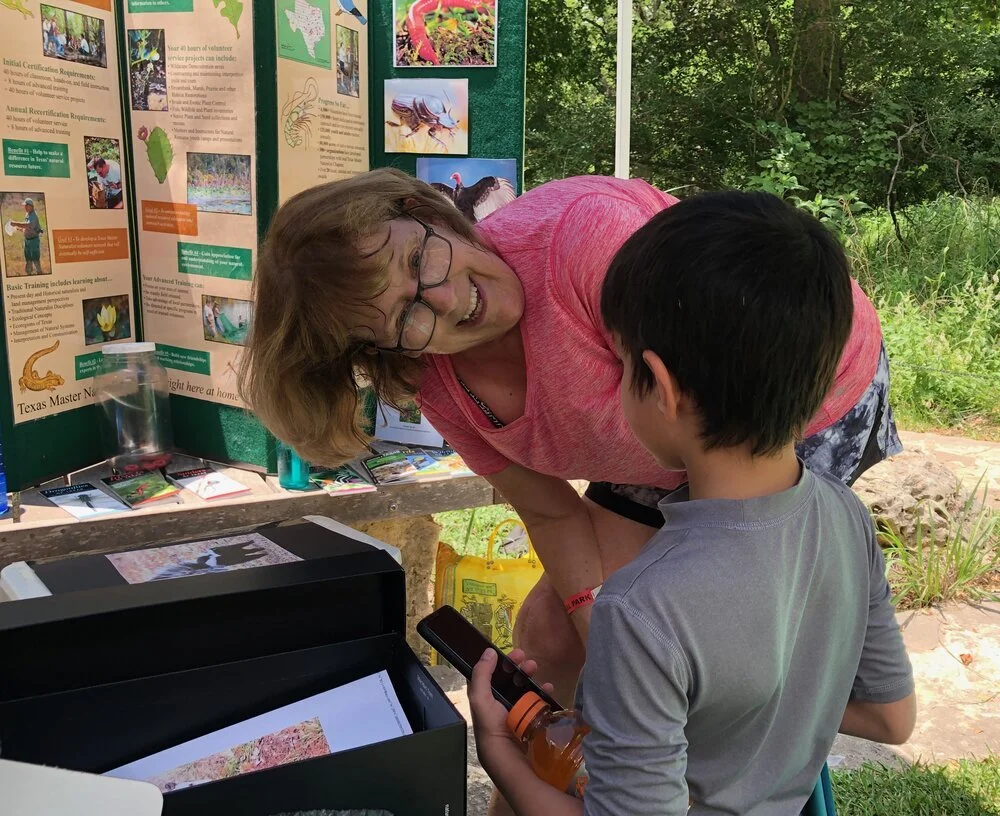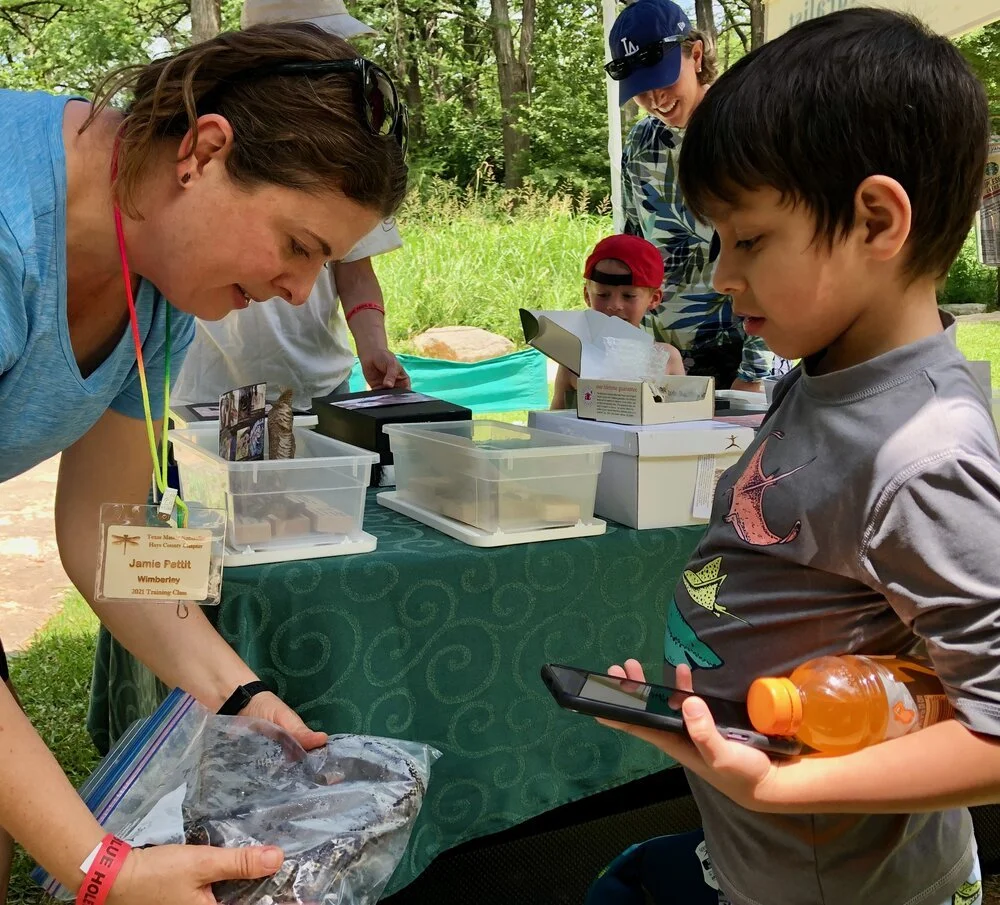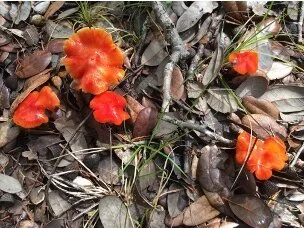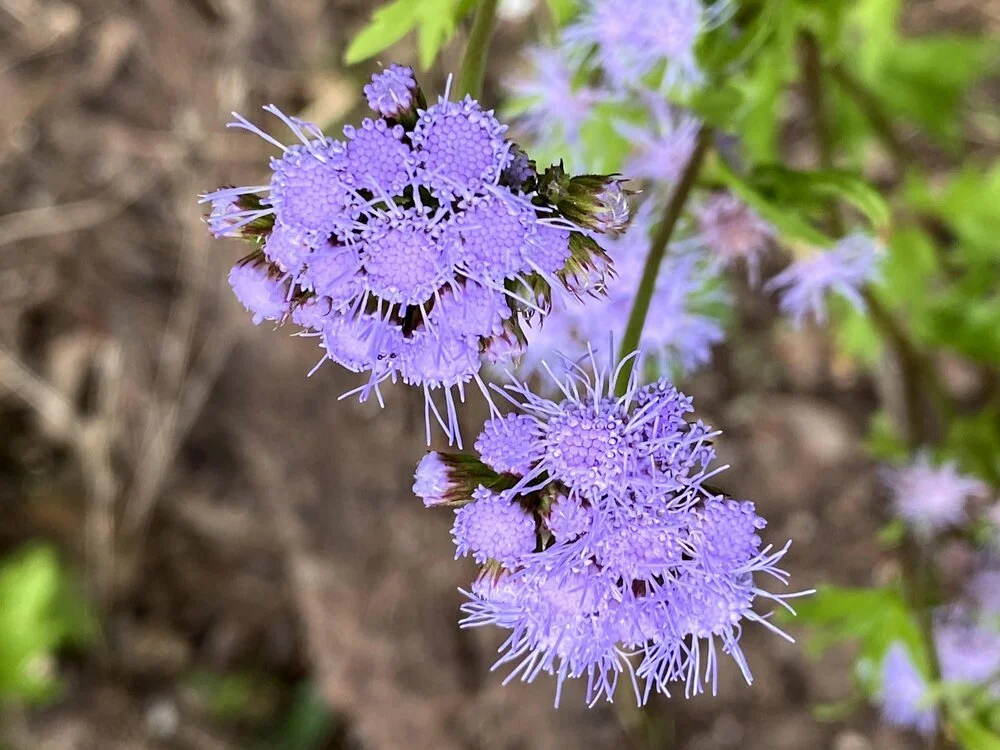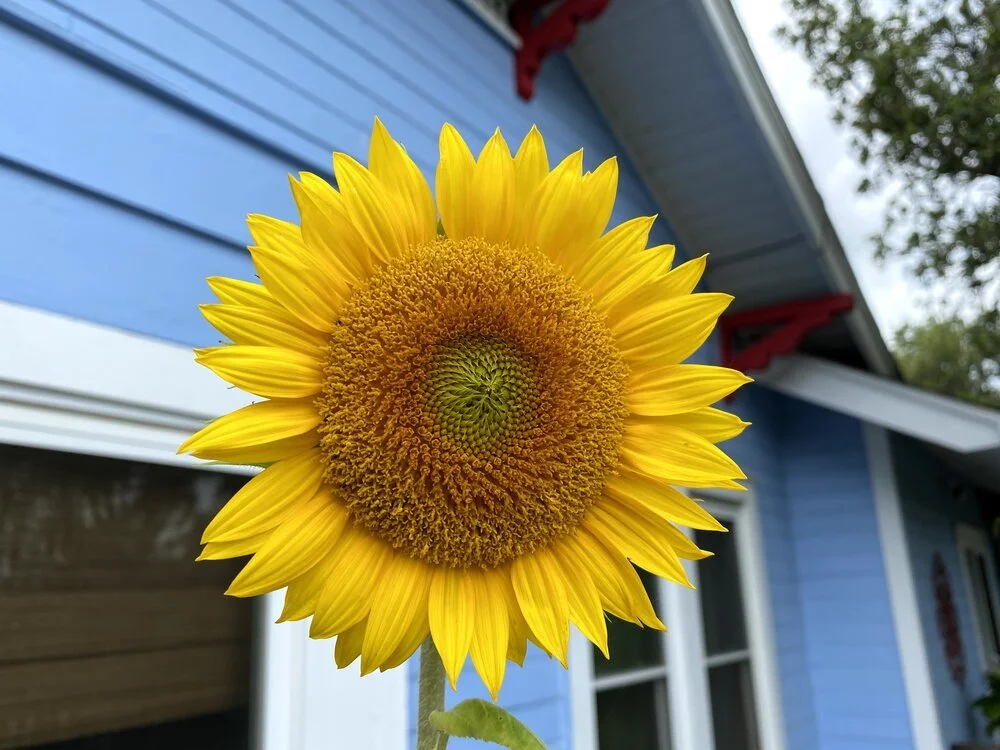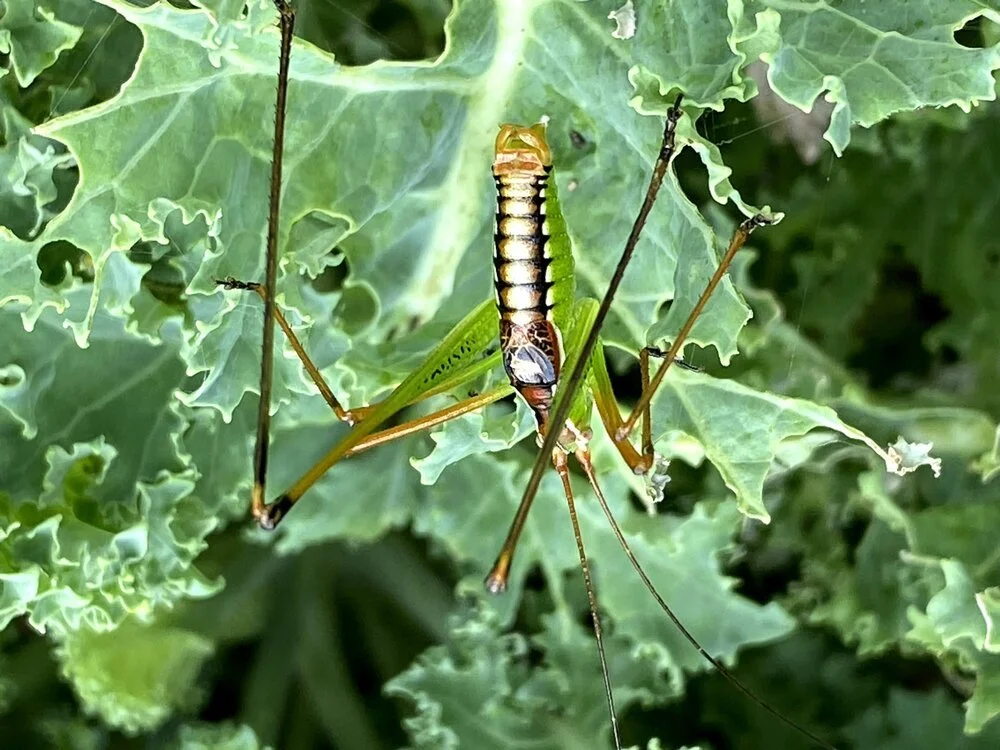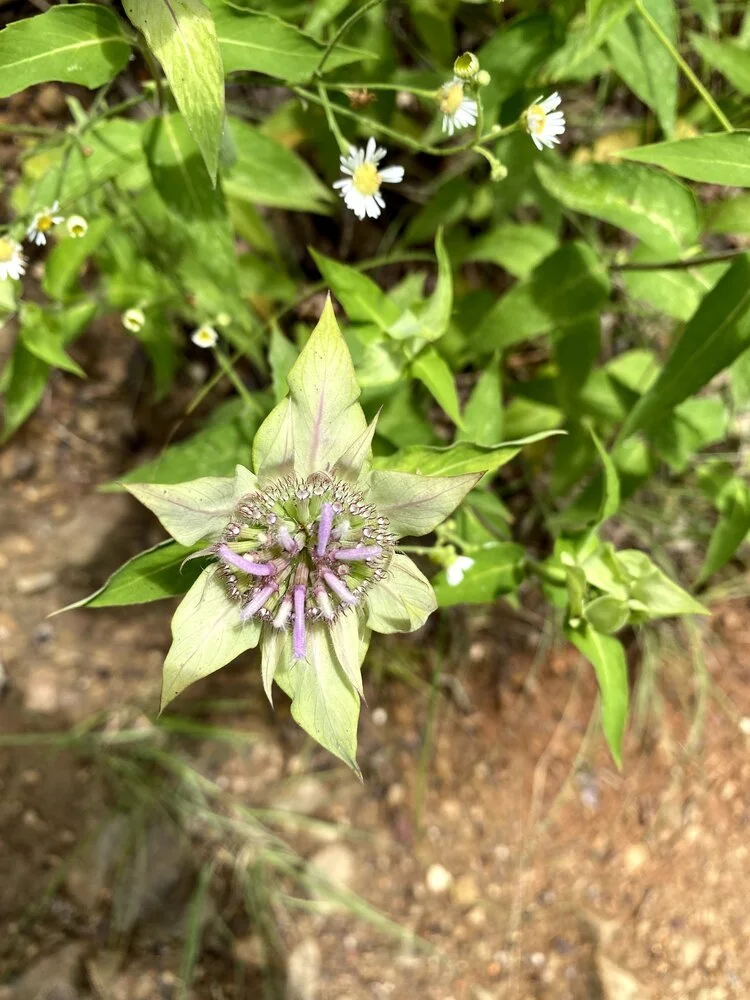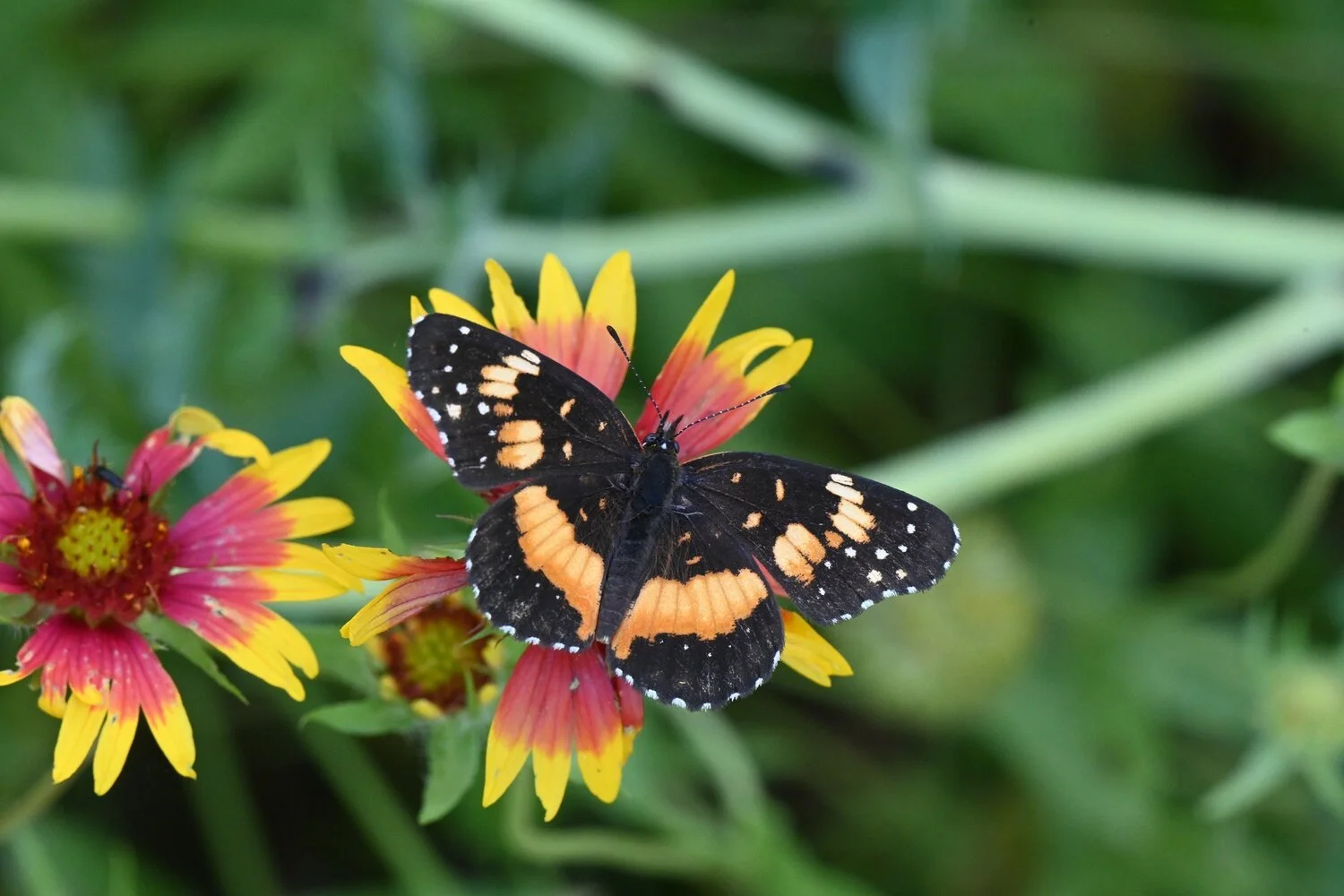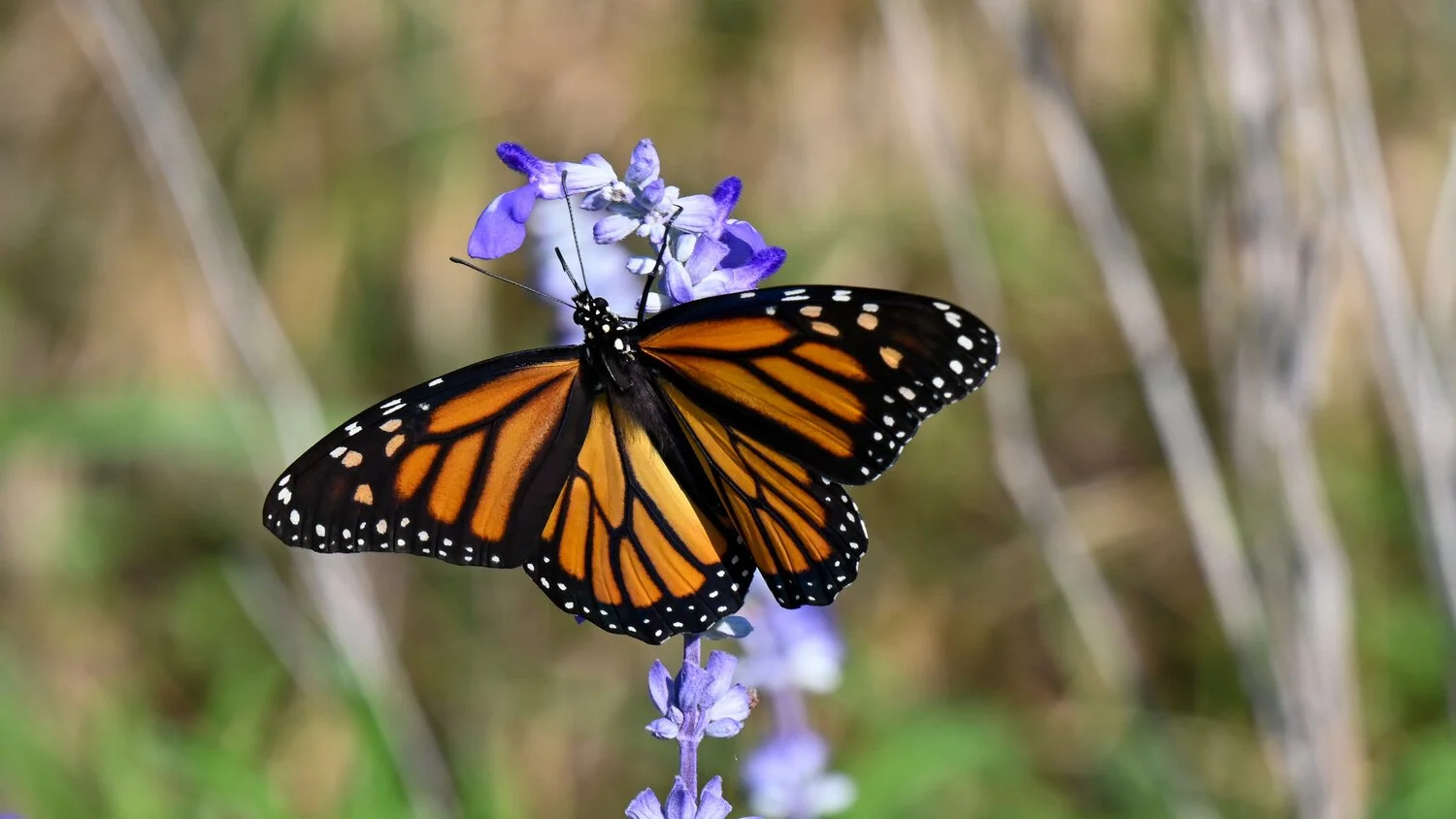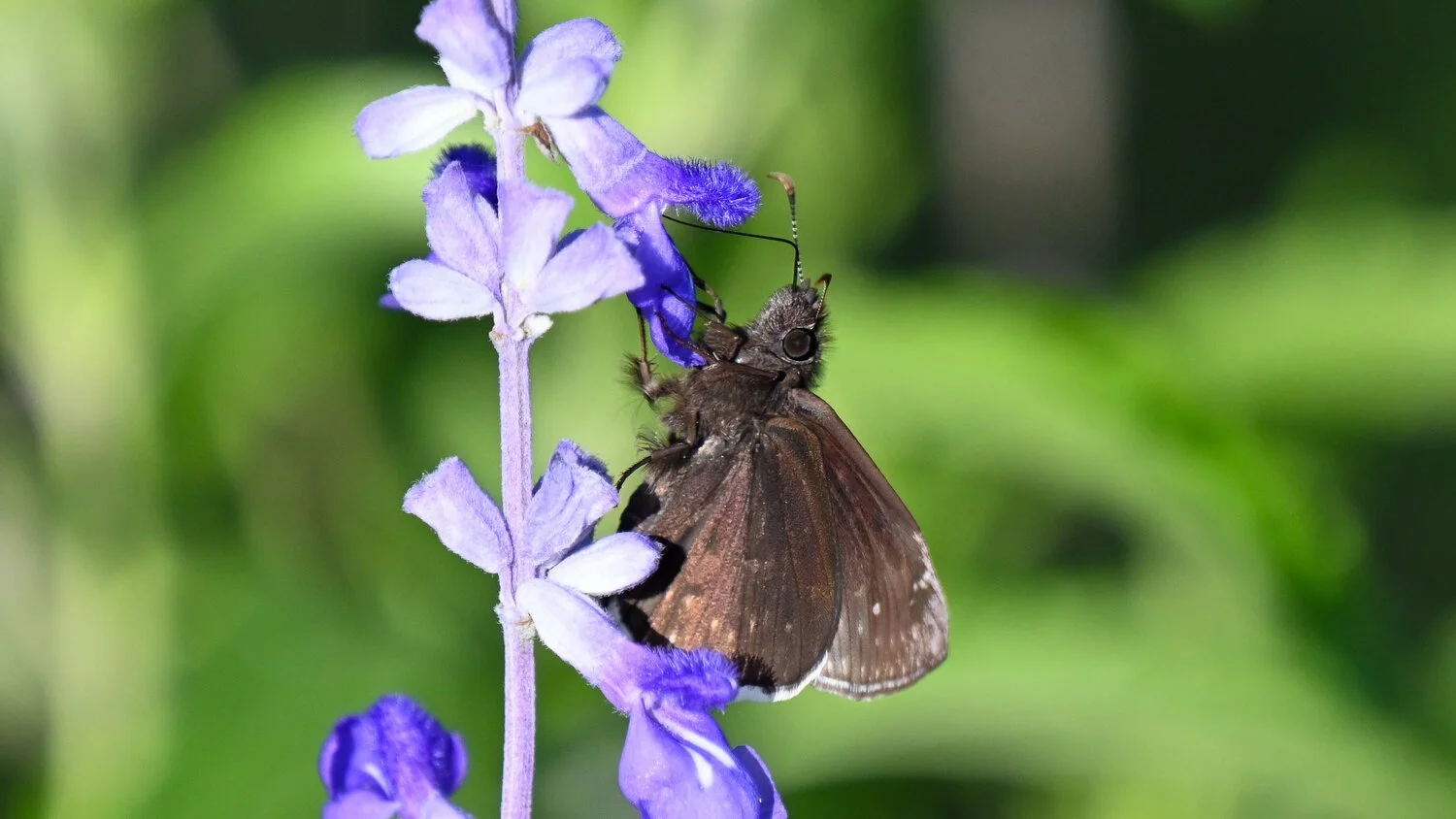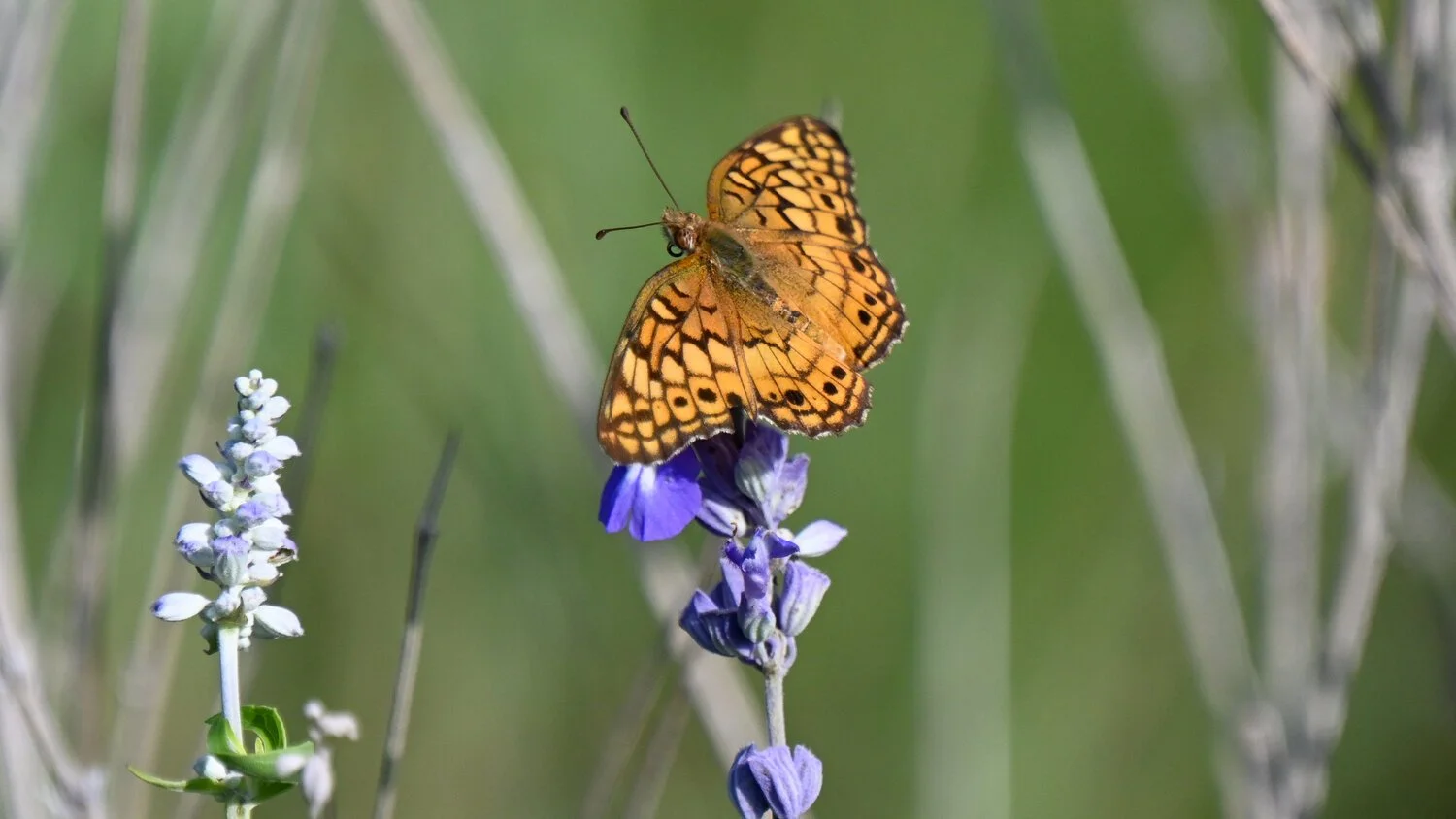The Hays Humm - July 2021
The Hays Humm
Award Winning Online Magazine - July 2021
Tom Jones - Betsy Cross - Constance Quigley - Mimi Cavender - Steve Wilder
Photo by Betsy Cross
Wren It Rained…
Mimi Cavender
It poured. For days. Which must have been inconvenient for a pair of Carolina Wrens in the family way. They’d house-hunted in the yard for weeks in early May, checking out the birdhouses. He’d claimed their year-round territory, this perfect little Wimberley acre with lots of cover, moths, bugs, and water. He was singing his loud Tcher-Rees-tcher, Rees-tcher, Rees-tcher, Rees-tcher! Hey, honey, check out this one. Smells only a little like titmouse.
Who knows how many trial nests they’d already built. Some of the little houses may have been hung too high—they like them 4 to 10 feet off the ground with a 1-inch entry hole. Or if not in bird boxes, they’ll nest in shrubs, tree hollows, your boots, flower pots—once even in one of those generic glass florist vases we’d stored on a 12-ft.-high shelf in the garage. We discovered the nest in progress and then had to leave the garage door open for an entire month: two weeks’ incubation and two from hatch to fledge. That smart pair knew they were safe from any squirrel, owl, snake, or raccoon. When the four chicks fledged, it rained little cinnamon fluff balls onto the concrete floor, from where their mother expertly coaxed them out into the wide, green, dangerous world.
But this little mother full of eggs knew what she wanted: not the usual tract home. Something sheltered but…different. That’s when she and her lifelong mate discovered a hanging basket in a live oak tree just beside the screened porch. An enormous Hoya carnosa weaves its waxy leaves around and around the basket and up the chain. Inside is a hollow space tented with heavy overlapping foliage—a living bird house. That titmouse had been interested in it, too, perching on the tree trunk and peering intently into the basket for minutes at a time. There’s nothing like competition to speed decision; the Wrens called their realtor.
The little look-alike mates then didn’t rest for three days; they built with intense focus. They’d found—and widened!—an opening in the tangled Hoya facing away from the yard and direct sun and only a foot from the supporting live oak trunk—a perfect staging perch for their methodical swooping in and out with nesting materials from the yard. First she poked in a scant base of sticks, then smaller twigs, then dry grasses, fine juniper bark strips, wads of live oak pollen bloom from the roof gutters, and—deep inside this 7” arched nest bowl—a softer lining of the finest dry plant fiber they could find. I’m not sure, but it looks like hair-thin bloom stems from a wild grass, densely coiled into the bottom of the nest. No feathers or dryer lint for these tough little Texans—just instinct and hard work. Then they disappeared.
We thought they’d reconsidered their choice. There were many other Carolina wrens and at least one pair of Bewick’s wrens in the yard, moving so fast that it was hard to sort them all out. As Dorothy famously exclaimed in Oz, “My, everyone seems to come and go so quickly here!” Did that blur of nesting activity include an attempt elsewhere by this same pair? Curious, we looked into the basket—the nest was at our eye level—only to get a loud wren scolding from somewhere in the branches above us. Hear that scold call here. That should have told us something. But the nest looked empty, and no adult had come to it all day. Coincidentally, during that same time our editor Betsy Cross was writing an article on her hummingbird nest photography for this magazine’s June issue; she mentioned her strict ethic of never approaching an active nest. Had we scared off our industrious little nesting pair? Oh, the guilt.
But just as that long week of rain set in, they were back. When we realized the nest was active, we peeked in and saw five beige rust-speckled eggs! Had she been laying those eggs all along? Maybe the nest was so deep and the space so dark that we just hadn’t noticed the accumulating egg clutch. So she’d been leaving the eggs to hunt for herself. Her mate was wrenning around taking care of business during the two week laying and incubation period, and would return to duty when hatchlings needed feeding. She’d come back in late afternoon and settle into the nest for the night. People—never Master Naturalists—find eggs without the mother on them and assume the nest is “abandoned.” And if you collect wild bird nests, even feathers, without a permit, it’s the penitentiary with bread and water for you! Here, from 1918, is one of the oldest environmental protections in United States Federal law: https://www.audubon.org/news/migratory-bird-treaty-act
It rained through that night and the rest of the week. Selfishly—sorry, Betsy—I began daily visits to photograph the whole nesting cycle—just a quick point and shoot and gone. I figured that if we hadn’t weirded her away by now, she was in it for the long haul.
Early the morning after that heaviest thunderstorm, when many Hays County folks got windshield-breaking hail, we feared the worst and rushed out into the drizzle to discover mother wren fluffed over whatever was under her. Wren hatchlings are quiet; it’s hard to know when they’re there, and we hadn’t seen any feeding activity yet. But there she was, disheveled, wet, and disgusted. Look at that face—hasn’t had her morning coffee. She was steadfast.
The following morning’s shoot finally revealed all five hatchlings, only a couple of days old. Notice the alpha chick, first laid, first hatched, most developed, at the front of the nest, where he (or she) would stay for the rest of the nesting period. The second chick is just to his right, and the other three are behind and under him, their eyes still covered. Birth order is important to survival. As we’ll see.
I began watching the nest from the adjacent screened porch and taking a photo almost every day. Since I had no idea when she’d begun laying her eggs, I can’t overlay a schedule on any of this. This is not good science or photography—or ethics, for that matter. But as any real nature photographer can tell you, the act of anticipating, then taking, then examining the picture makes you a better naturalist. You see and remember more detail.
As the rain dried up and days grew longer, this wren pair worked together like a machine to feed five chicks. There were constant arrivals, averaging a minute apart— yard to tree, into nest, out of nest, and back to yard for another moth, dragonfly, or caterpillar larva. The chicks never called but made a few soft peeps only when the parent neared the nest, signaling with her own soft chip! When I approached for the daily photo, they knew to stay absolutely still. Even the alpha chick hunkered down, so that often all I could get was a nest full of wide yellow beaks or just the top of their shiny little black heads.
A word about fledging. The verb fledge originally meant put on feathers, as it still does in its variant fletch—when a traditional archer affixes trimmed turkey wing feathers to a wooden arrow shaft. The English family name Fletcher was of skilled craftspeople who fletched arrows for a living. Today, ornithologists use the word fledge to mean leave the nest, with or without flight. You might say our kids, too, someday will fledge… Anyway, as our wren chicks’ two-week maturation toward fledging progressed, their shiny black fuzz became greyer and then cinnamon brown; their bright yellow beak corners narrowed and faded to grey brown; the iconic black and white eye streaks and white throat became more and more defined; the cinnamon fluff on head, back, and wings became specialized feathers; and their breast and belly became a soft light beige. At fledge, they should look like a slightly fluffier version of their parents.
The alpha chick was the first, by four days, to resemble her parents. Look at her, stretched across the rest of her siblings, just itching to fledge. Next to her, standing up, number two still had that Second Child look, Wait for me! The others, always under foot, wanted—and needed—to stay right there. It’s a mystery how any of the bottom-nesters had been fed enough to have developed this far. We hadn’t seen the fifth chick for days. And then we smelled him.
So was it birth order that determined what happened next? Was it the dead chick? Or was it my daily visits? Whatever sped things up, there was nothing to do about it; several days short of two weeks, the fledging started. Suddenly there was louder, more constant calling and twittering. I noticed a parent removing fecal sacs from the nest porch and neatly depositing them together on a nearby rock wall. The fecal sac hygienically encases a nestling’s urine and excrement, keeping the nest clean—bird diapers! Carolina wren chicks defecate within a minute of feeding; they turn and lift their tail toward the nest porch and deposit the sac on or over the edge. The parent immediately removes it to a nearby location and continues hunting and feeding. Here’s an absolutely fascinating Facebook video of pre-fledge Carolina wrens.
So the begging, feeding, and elimination cycle became more intense, more urgent. Then Alpha made her move. That afternoon, watching through the porch screen, I saw her perched on the front edge of the nest, working her wings. Minutes later she moved out onto the encircling Hoya stems. The second child was poised to follow. Lots of flapping and cheep-cheeping. Alpha hopped from nest to tree trunk. The other four fluttered awhile, then followed her out. Alpha then actually flew to a nearby rock wall and into some mountain laurels beyond. Second Child walked up the tree trunk into the canopy and eventually joined Alpha out beyond the wall. The last two, still developing their flight feathers, could only plop onto the ground and slowly flutter-walk over into a corner at the base of the wall, where they stayed huddled together in the waning sunlight. We found the dead fifth chick at the bottom of the nest, where he’d spent his nestlinghood pondering the underside of his siblings.
The parents? They were with the first two; they’d herded them under a dense elaeagnus bush and were busy feeding them. Neither parent visited the huddled weaker chicks. Is this a survival mechanism for everyone but the weak chicks? I cringed at the thought of their being easy prey for raccoons, owls, snakes, and cats. So—ignoring Darwin—I tented them with some light brush and went to bed, hoping for the best. They were gone the next morning, as were the rest of the new family. Out there in the summer heat, our Texas Hill Country Carolina wrens are busy working the tree trunks, calling, singing, scolding, mating, and making families. Even, we hope, in the rain.
By the way, did you know they sing duets? And are you sure you can tell Carolinas from Bewicks? There may be some surprises for you at Audubon and All About Birds.
Cypress Creek Waterfall over Woodcreek Drive low water dam, June 6th
Following 3.6 inches of rain in early June, elevated creek levels create scenic waterfall over low water dam. The pool downstream of the dam is adjacent to Eagle Rock and the Cypress Fall Lodge.
Now that the summer heat has arrived, let’s take a look back and remember the six weeks of cool wet weather in May and early June. It was an exceptional period for rainfall in the Wimberley Valley, an area dependent upon rain to keep its iconic springs and swimming holes flowing. The May rainfall total was 6.8 inches, followed by an additional 3.6 inches the first week of June. In this six-week period a total of almost 10.4 inches of rain was recorded. The rain provided welcome relief to the drought conditions experienced earlier this year, when we worried Jacob’s Well would stop flowing.
I made several visits to Jacob's Well and the Eagle Rock area to photograph Cypress Creek following this rainfall event. Cypress Creek’s length is 14.4 miles, but it is dry for the 9.5-mile upper segment above Jacob’s well. Over 65% of Cypress Creek is not contributing significant surface water flow, which is typical for small watersheds. The upper creek segment above Jacob's Well flows only during high rainfall events. My visit to Cypress Creek in early June allowed me to view and photograph Cypress Creek in a high flow condition.
June 5th Jacob's Well Natural Area - Dry Cypress Creek
The photo was taken a day after 1.5 inches of rain. The lack of surface flow after a significant rain is typical for small creeks. The easiest path for water in the upper watershed is into the rock layers rather than flow down the creek.
June 6th - Dry Cypress Creek now flowing
After another 1.6 inch rainfall, note the change in creek flow. It is the same segment of Cypress Creek as seen in the previous photo, this time with significant water flow.
On June 6th, Jacob’s Well recorded one of the highest flow rates of 2021. In the photo below, the water surging out of the spring looks like it is boiling. Jacob’s Well was not the only spring along Cypress Creek with high flows. The cover photograph shows a high flow over the Woodcreek Drive low water dam. Near Camp Young Judaea, multiple springs in this area contribute water to Cypress Creek. The large wide pool behind the dam is a good view of a very full Cypress Creek.
I frequently visit and photograph Jacob’s Well spring. The three photographs below highlight the swimming hole at various flow conditions. The photos from January and February 2021 were taken following concerns that the spring had stopped flowing. The latest photo taken on June 6th, shows Jacob’s Well at its highest flow rate for this year.
Spring 2021 Panhandle Plains Texas State Park Tour - Constance Quigley
Palo Duro Canyon overlook from park entrance
Visiting all 89 Texas State Parks is a bucket list item for me. I’ve been to several over the years, but I hope to see each one with a naturalist’s eye over the next year or two. In May I declared Road Trip Tuesday to calendarize my intention. This quickly became Road Trip Thursday due to conflicts and weather events, but so far I’ve been to 6 of the parks near Hays County: Palmetto, Beuscher, Bastrop, Honeycreek (State Natural Area), and Lockhart. A couple of weeks ago my partner and I decided to take a trip to the Texas Panhandle to knock out a few more. We intended to fly in his Cessna 172, but the weather changed our plans to another, longer, road trip. It was a wonderful adventure seeing the changing landscape of Texas after all the spring rains. The parks were lush, green, full of wildflowers, and surprisingly empty of people.
If you ever need a refreshing soul-cleansing experience, I highly recommend a hike at one of our fantastic state parks. And you’re always welcome to join me on Road Trip Thursday! Upcoming: McKinney Falls, Pedernales Falls, Hill Country (SNA), Guadalupe River, and Blanco. We’ll also be going to Old Tunnel one evening to watch the bats emerge!
Lake Mineral Wells State Park
Project 2001 Update
Texas Horned Lizard Release
Constance Quigley
Photos by Tina Adkins & Constance Quigley
Photo by Tina Adkins - an undisclosed, private stretch of the Pedernales River
Isn’t the Pedernales just beautiful? I wish I were a horned lizard so I could just look at this all day… a lizard’s eye view…
On Friday, June 18th, a small group of Texas Master Naturalists joined a group from the San Antonio Zoo led by Director of Conservation and Research, Dr. Andy Gluesenkamp, with trained dogs from Chiron K9, led by company owner Paul Bunker. This team would search for signs of horned lizards that were released in 2020 at a private property near Dripping Springs. Hays County Master Naturalists in attendance were Steve Janda, Mary O’Hara, Cynthia Grant, Tina & Bob Adkins, Kathy McElveen, and Constance Quigley.
Our mission was to locate horned lizard scat, which resembles large raisins.
Horned Lizard habitat - a Hill Country paradise
It was not an easy task, considering we were walking several acres of land that are now covered with wild flowers! The dogs signaled a couple of times, but no one identified any scat on this outing.
As you can see, this is an expansive habitat for our tiny lizard friends. They have numerous and very healthy harvester ant mounds for their dining pleasure and a huge area to inhabit. It isn’t too surprising that we did not locate any lizards or scat. Hopefully, the next group of searchers will have more luck.
After a couple of hours, we abandoned our mission, and the generous landowner treated us to a visit to a private swimming hole to cool off (See that first photo - yes, really!), along with a very tasty BBQ lunch. The hard-working dogs and people enjoyed swimming in the cool water. I’m sure the horned lizards were relieved to see us leave so they could resume appreciating that view!
Thank You Contributors
Tina Adkins, Art Arizpe, Mimi Cavender, Christine Middleton, Constance Quigley
WILD ABOUT NATURE
Christine Middleton and Mimi Cavender
You could say we Master Naturalists are wild about Nature—or we wouldn’t be Master Naturalists. We wouldn’t go through a year of volunteering and training for certification, then balance our jobs or retirement with volunteer hours to keep that precious certification: reading, writing, photographing, observing, reporting, talking and teaching, maintaining parks, trails, wildlands and wetlands, and artfully convincing civilians of the virtue in doing the same.
Passion sustains what we do. Many of us learned to love the wild world as children, and we’ve been lifelong learners ever since. Do you remember the parent, teacher, friend, book, documentary, park, camp, summer vacation—when Nature made you wild? You were young. She’s embraced you and has never let you go.
We know this early-formed habit of lifelong learning about the natural world gives joy and does good. If we can spread our enthusiasm to others—especially when they’re young—they too will spread the joy and do the good. We know the world needs it.
Spreading the Joy, Doing the Good
You read about the Hays County Master Naturalist outreach to Hays landowners in Betsy Cross’ article READING THE LAND: Habitat-Enhancing Land Management (HELM) in the March 2021 Hays Humm issue.
A second HCMN educational outreach program headed by Project Manager Christine Middleton is the newly launched WILD ABOUT NATURE, designed to engage children and their families throughout Hays County. Christine’s team includes Neeta Allen, Carolyn Bauknight, Deb Bradshaw, Mimi Cavender, Debra Kennamer, Dorothy Knight, Lee Ann Linam, Jamie Pettit, and Lin Weber. The group has been meeting since last November, mostly on Zoom, learning more about what other Master Naturalist chapters are doing and setting a path for the chapter to proceed in ramping youth/family education activities. More recently, the team has been busy designing activities and acquiring materials using money from a Firefly (Willett) grant.
Here’s Christine to tell you about it.
The first four educational tracks for WILD ABOUT NATURE are:
Track One: Wild About Birds focuses on birds commonly seen around Hays County in the wild as well as in backyards and parking lots. It highlights bird adaptations (such as beaks and feet) and migration strategies, and provides information on how to attract more backyard birds.
Track Two: Hide & Seek CSI focuses on how we know animals are there without seeing them by the signs they leave (skull, tracks, scat, burrows) and hones observational skills that open up a better understanding of the natural world around us.
Track Three: Creepy Crawly focuses on our sometimes unloved neighbors (snakes, insects), their intriguing lifecycles, the role they play in our ecosystem, and how eliminating one species can have unintended consequences for others, including us.
Track Four: Wet and Wild focuses on animals whose lives are intimately tied to water (otters, frogs, fish, and macroinvertebrates) to raise awareness of the importance of protecting the quality and quantity of our water.
Additional tracks will be added as the WILD ABOUT NATURE program expands. The programs will be provided either in association with Project 704-Outreach or through other Hays County Master Naturalist projects seeking to add a youth/family educational component to their efforts.
The initial focus has been on tabletop activities (pop-ups) and small hikes at local parks. The first official WILD ABOUT NATURE event took place at Blue Hole on June 25th, and the plan is to return to Blue Hole on Fridays throughout July and early August.
During May, 2021, conditions were just right—ideal temperature, moisture, pH, nutrients—for mycelium or fungal organisms to produce an amazing variety of fruiting bodies. On our property we measured 8.75” for CoCoRaHS, a rain amount that would stave off the drought for another month. I couldn’t help but notice an array of colored caps floating from the ground on cylindrical stalks or mini crescent shaped frisbees fused to the trunks of mature juniper or oak. So befitting our microclimate, I hunted as many macroscopic fungi erupting from my land as possible. You might say I was a bit “fruity” during the slow drizzling rains.
Not only was I searching for a variety of color, shapes, sizes, tubes or gills, but I was hoping to cast a Hartig net around my world to determine if my soil and the root systems of my plants and trees were all interconnected. Fungi can’t produce food for themselves, so they rely on decaying matter to absorb the carbohydrates and nutrients they need from host plants while the host plants can obtain water, nitrogen, phosphorous, and potassium from the mycelium. What a perfectly beneficial mycorrhizal relationship all hidden in the dirt!
Bending my head and kneeling to reorient my perspective on life, I sought ectomycorrhizal relationships beneath the canopy of trees. Of course the fruits that first caught my eye were the brightest, shiniest and most colorful—the Candy Apple Waxy Caps (Hygrocybe cuspidata.)
The eye-popping waxy caps were hard to beat. Yet with more surface scoping, I encountered more red, reddish orange, but rather lusterless fruiting bodies. The next grouping includes various Boletes; a densely populated category. Their sponge-like undersurface consists of vertically arranged tubes, each terminating in a pore.
Perhaps not as colorful or shiny, but still eye catching, are the unusual shapes and sizes of fruiting bodies with quirky fertile surfaces and support structures, some with gills and some without stalks.
The second group, the decomposers, or saprotrophs, extract nutrients they require from dead and decaying matter. These are often fused in semicircles or fans to tree trunks so that they can be stalkless. These polypores can occur singly or in clusters. They have woody or leathery fruiting bodies with pores on their under surfaces.
I discovered some Scleroderma citrinum, commonly known as poison pigskin puffballs, and also some common earth balls and some earth stars. After all this exploration down under, I was feeling very earthy.
The third group of fungi are the parasites attacking plants and other fungi to meet their needs for survival. These include molds and slimes, which feast on other fungi.
The Bolete Mould completely covers its host Ruby Bolete, cycling through 3 stages: (1) White mold with asexual spores, (2) powdery yellow asexual spores, and (3) the sexual stage, which produces ascopores, which are globose jewels embedded in a tan dough-like substrate. Pretty amazing stuff, molds within fungi within decomposing leaves and twigs. What will nature come up with next?
Stories and folklore regarding Star Jelly abound, dating back to the 14th century. Speculations range from gelatin deposits from meteor showers, or the remains of frogs, toads, or worms, or—more recently—the byproduct of cyanobacteria.
Many beneficial mushrooms provide a network of fine filaments called hyphae which surround the roots of plants to form a protective sheath or mantle. Changing my visual perspective was thoroughly enlightening to discover a myriad of fungi in my own backyard. Imagine the observations and discoveries in other environments! Imagine a mutually beneficial relationship with all living organisms, vascular plants, trees, animals, and humanoids, where each obtains nutrients and water from another. These interwoven root systems are thoroughly interconnected, protecting one another and providing the basics of survival for all. Perhaps we should change our perspective and allow ourselves to participate in this model and learn from nature. “It’s elementary, my dear Watson,” my mycorrhizal friend.
Silvery Checkerspot
PLANTING FOR POLLINATORS
June 21-27 was Pollinator Week —What’s growing in your pollinator patch? Find more information or share stories and successes here at Pollinator.org.
Click on any row below to see these photos in full size. Photo contributions by Constance Quigley (first six photos), Mimi Cavender (honey bee), and Betsy Cross (butterflies and hummer.)



